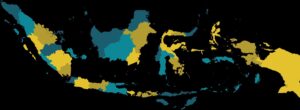Things to Do in Ozurgeti & Guria: Georgia’s Tea Route
32 min readThe smallest region in Georgia, Guria is one of the least-visited yet most unique places in the country.
Since first visiting this corner of Western Georgia in 2020, I have become something of a serial Guria tourist. I come here at least once a year, and have been lucky enough to explore most of the area as well as attend several unique Gurian cultural festivals.
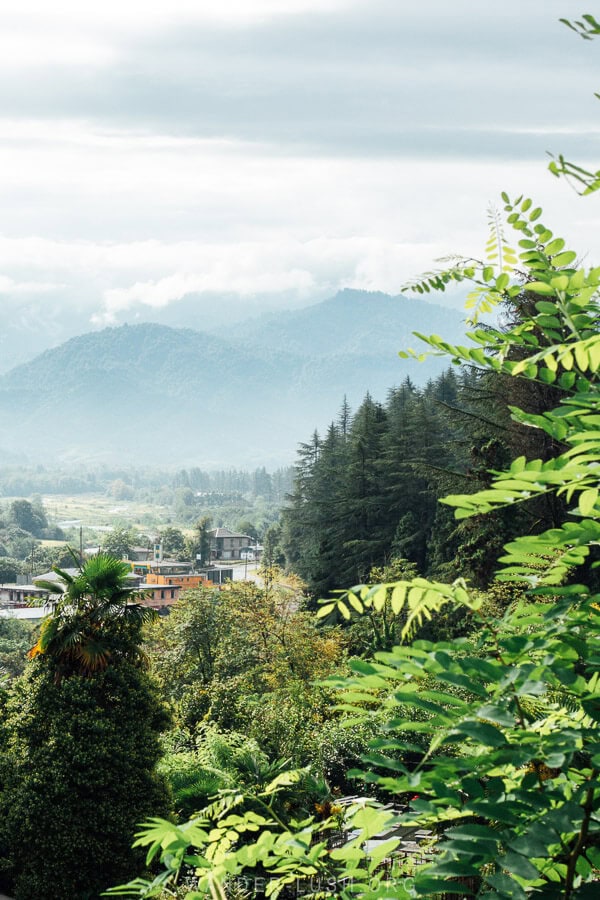
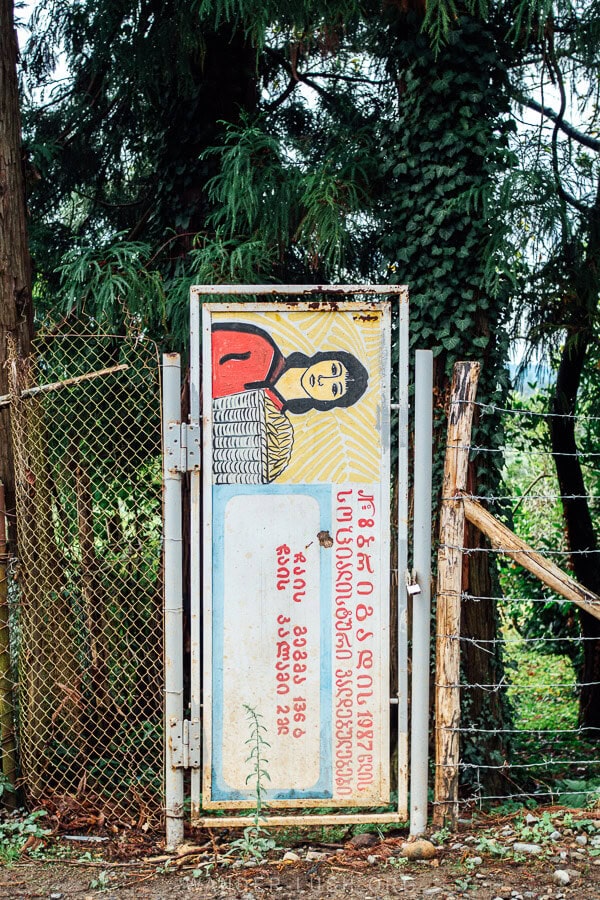
Once the hub of Georgia’s tea industry (which accounted for 40% of the economy in Soviet times), Guria is now the focus of the new Tea Route, which unites independent tea specialists.
This is what first drew me to visit Guria. In my eyes, the Western Tea Route is every bit as interesting (and delicious!) as the Kakheti Wine Route in the East. (If you prefer something harder, Guria has its own special winemaking traditions, too.)
Another thing I love about Guria is the architecture and sense of nostalgia. As you make your way around, you will see hints of the Soviet past in the rusted skeletons of shuttered tea factories, remnants of beautiful bus stops, and majestic mosaics.
Some of the most impressive Culture Houses and abandoned village halls can be found in Guria, making it a paradise for photographers and urbexers.
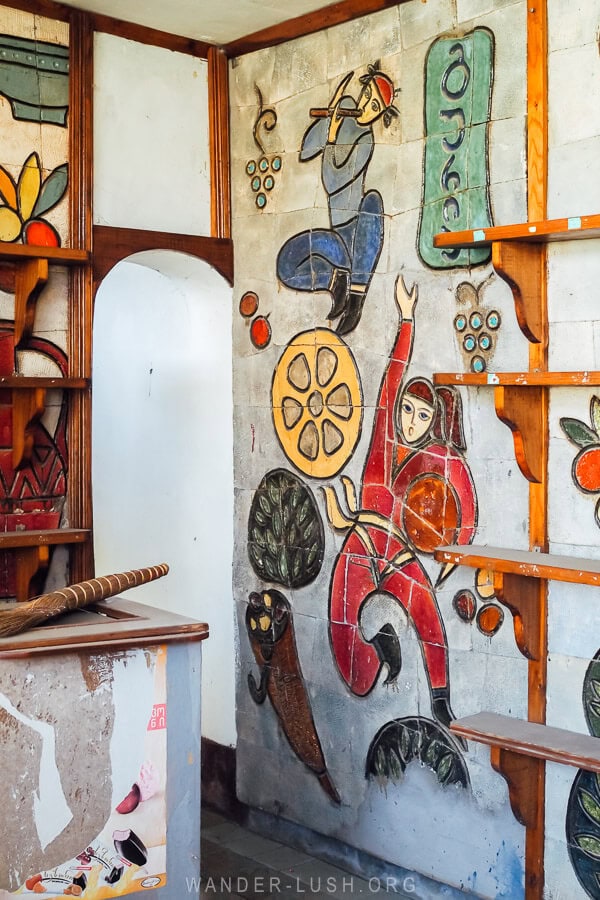
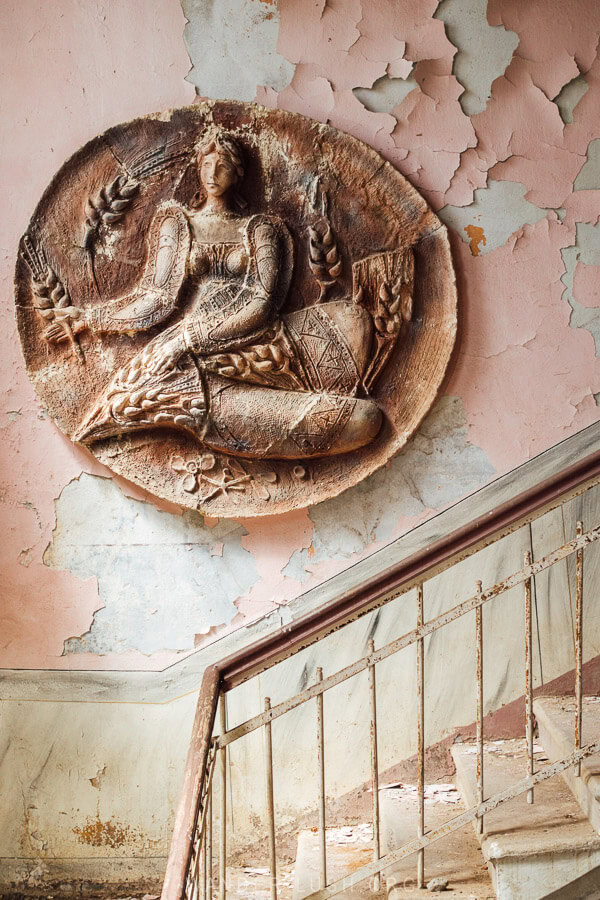
Guria has its own folklore, dialect, and a unique cuisine – including a local khachapuri with boiled eggs that is a must-try.
It has a rich culture tied to horsemanship (the story of the Gurian Wild West riders is a fascinating one!), on show at the annual Bakhmaro Doghvi. Another festival, Lelo Burti, pits two villages against each other in a fierce (sometimes fatal) fight for a giant ball filled with 16 kilograms of sand.
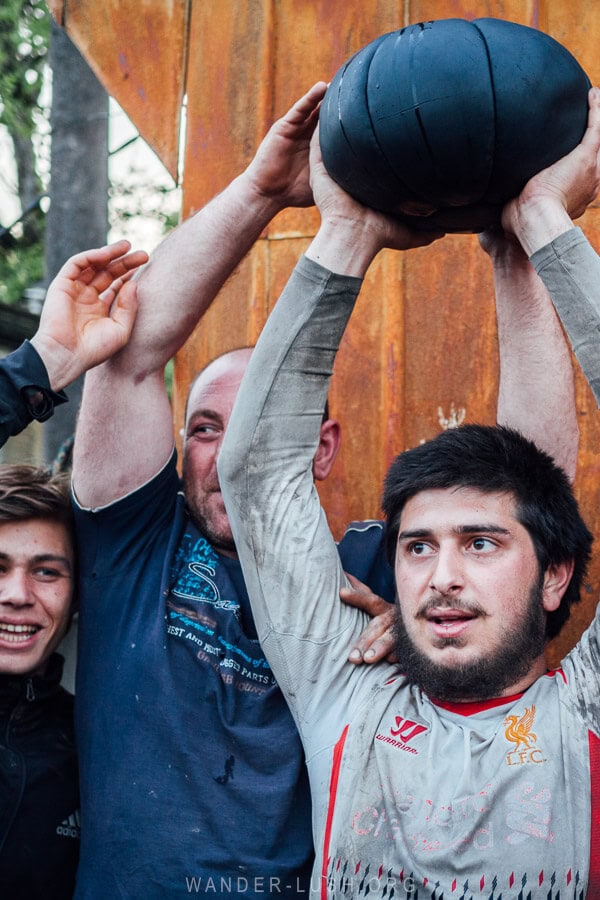
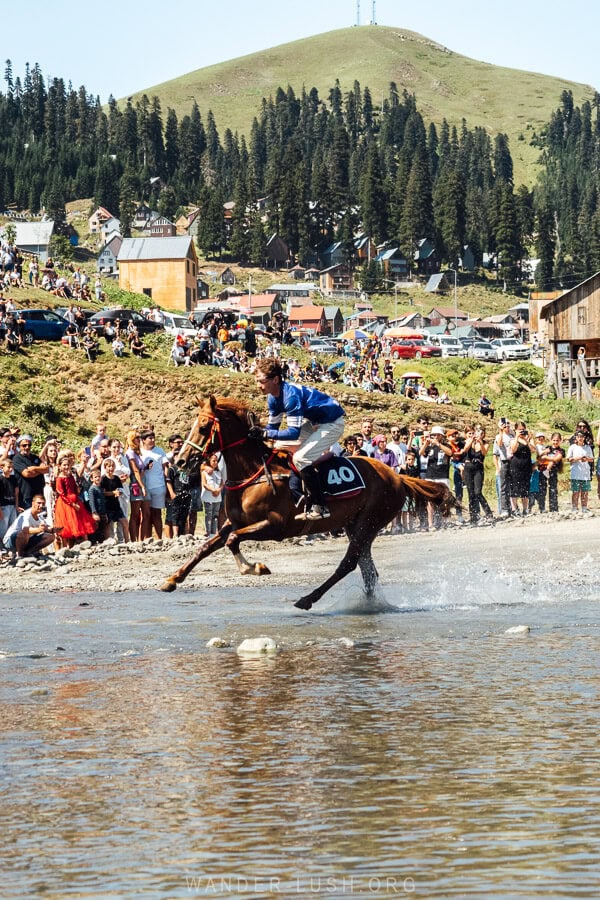
Guria’s diverse landscape varies from high mountains to a leafy interior and a sliver of Black Sea coastline.
The two popular mountain resorts of Gomismta and Bakhmaro, which sit atop twin peaks overlooking Ozurgeti, the biggest city, are both beloved for their A-frame cottages, sunset views, and hiking trails.
Moving towards the coast, the landscape changes to thick, humid forest before you land on Guria’s black sand beaches, less developed and much more serene than those down the coast in Batumi.
This guide covers the best things to do in Ozurgeti and across Guria region, plus my travel advice for including Guria in your Georgia itinerary.
Please note: This post contains affiliate links, meaning I may earn a commission if you make a purchase by clicking a link (at no extra cost to you). Learn more.
Best time to visit Guria
Guria has a subtropical climate. It is warm and sticky in summer, and chilly (and snowy!) in winter. Summer high season (especially July and August) is busy on the coast and can be very humid.
I have visited Guria in every season, and I can recommend either late spring or autumn as the best periods for mild temperatures and clear skies.
Spring comes early to this part of the country, and the period around Orthodox Easter is one of the best times to travel.
If you want to include Gomismta and/or Bakhmaro, note that the mountain roads are only navigable by snowmobile in winter and normally reopen to traffic in late May or early June.
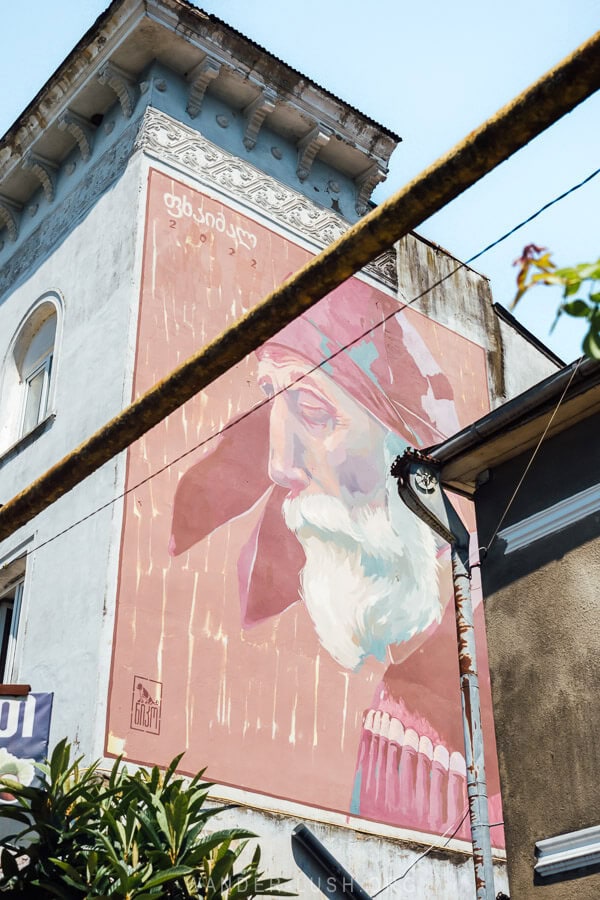
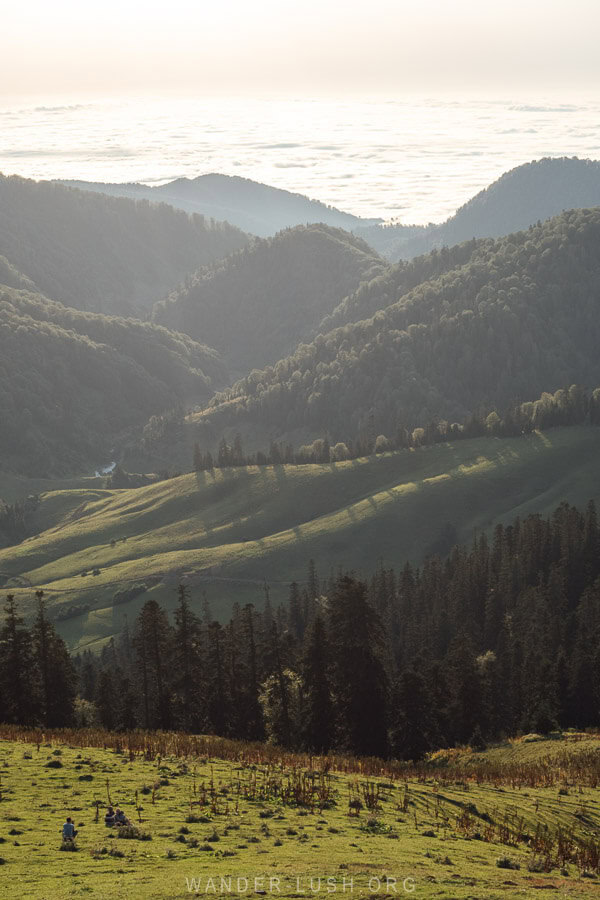
How to get to Guria
Guria is located off the main highway between Tbilisi and Batumi, and has good rail and road transport connections as a result.
The most convenient place to arrive and to base yourself is Ozurgeti, the region’s main city and transport hub.
By train from Tbilisi
There is a daily morning passenger train to Ozurgeti from Tbilisi. It is an older train (not the fast Stadler train that runs from Tbilisi to Batumi), thus the journey takes a good 9 hours.
Tickets cost 10 GEL and can be purchased online in advance via TKT.GE.
By bus from Tbilisi, Kutaisi or Batumi
Marshrutka minivans to Ozurgeti are available from every major town and city across Georgia.
By road, Ozurgeti is 50 kilometres from Batumi, 85 kilometres from Kutaisi, and 300 kilometres from Tbilisi.
From Tbilisi, vans depart from Didube Bus Station every 60 minutes throughout the day. Additionally there is one coach bus to Ozurgeti that leaves from the small depot behind Central Railway Station (see the location here) every morning at 10am. Travel time is around 6-7 hours, and fares are around 30 GEL.
From Kutaisi, Ozurgeti is just 2-2.5 hours by road. Marshrutka vans depart from the main bus station (see the location here) every hour between 10.30am and 3.30pm. Tickets cost 12 GEL.
From Batumi, vans depart from the bus station near the Agricultural Market (see the location here) every 60-90 minutes throughout the day, starting from around 10am. Travel time is 2-3 hours, and the fare is around 15 GEL.
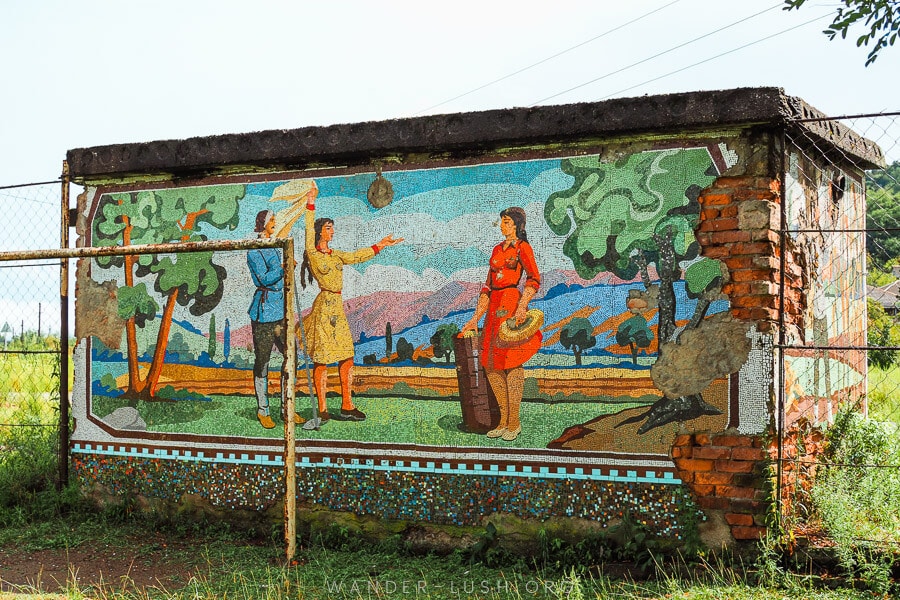
By car
Guria is a terrific place to explore with your own car. The roads in this region are generally well-maintained and quiet, including the roads to Bakhmaro and Gomismta which are both newly sealed.
Transport connections within the region are very limited, so you will see a whole lot more if you have your own wheels. This is why Guria features as one of the main destinations on my Georgia Road Trip Itinerary.
I personally use Local Rent whenever I hire a car in Georgia. The website aggregates local agents so prices are always great, and many vehicles come with comprehensive insurance included (and often no deposit). Read my tips for driving in Georgia here.
If you are coming from the east (Tbilisi or Kutaisi), I recommend using the Nasakirali Road. It is a bit windy but very scenic. Along the way, stop at the Nasakirali Battle Monument, a tribute to the 1905 Gurian uprising against the Russian Empire.
By taxi
If you want the flexibility of having a car but you prefer not to drive, a one-way private transfer to Ozurgeti from Tbilisi (or anywhere else) can be booked through GoTrip.
As well as having an experienced driver and flexible departure time, you can stop wherever and whenever you like along the way – one of the reasons I prefer using GoTrip over vans for longer road journeys. Read my review of GoTrip here.
Where to stay in Guria
Komli Farmstay (Tsitelmta): This village farmhouse has a small tea plantation and a creek running through the back garden. Hosts Meri, Lika and Mariam offer homely rooms and exquisite meals. Komli is on the Tea Route and also offers degustations and tours. The house is located around 10 minutes’ drive from Ozurgeti (transfers available). Book direct via the website.
Menadbe Winery (Shemokmedi): This gorgeous wine cellar-guesthouse is set inside a heritage wooden oda and features a sprawling yard, wine tastings, and an onsite restaurant. The location 10 minutes’ drive from Ozurgeti is convenient if you have your own car. Rooms are extremely romantic and cosy. We had a great stay here on our second trip to Guria and returned again recently for my birthday. Book here via Booking.com.
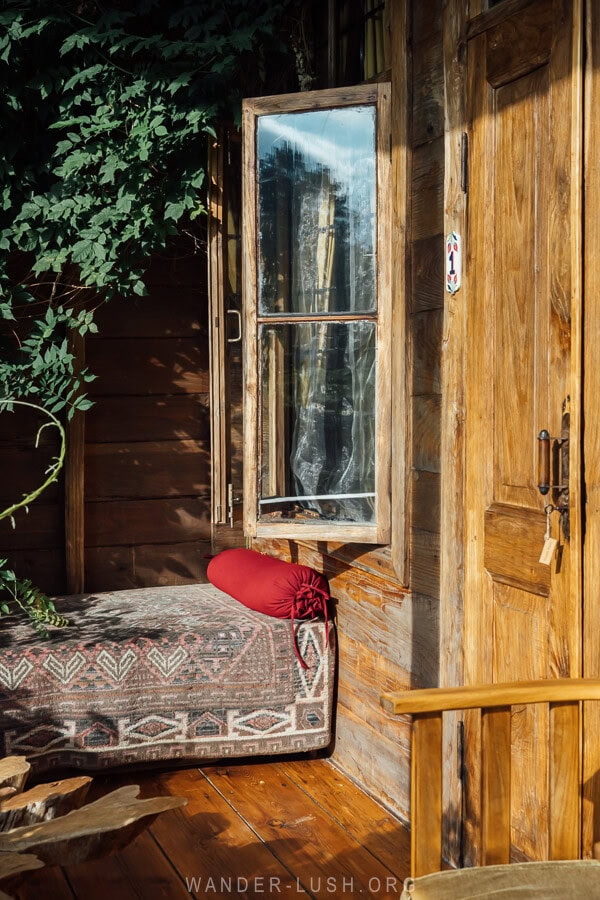
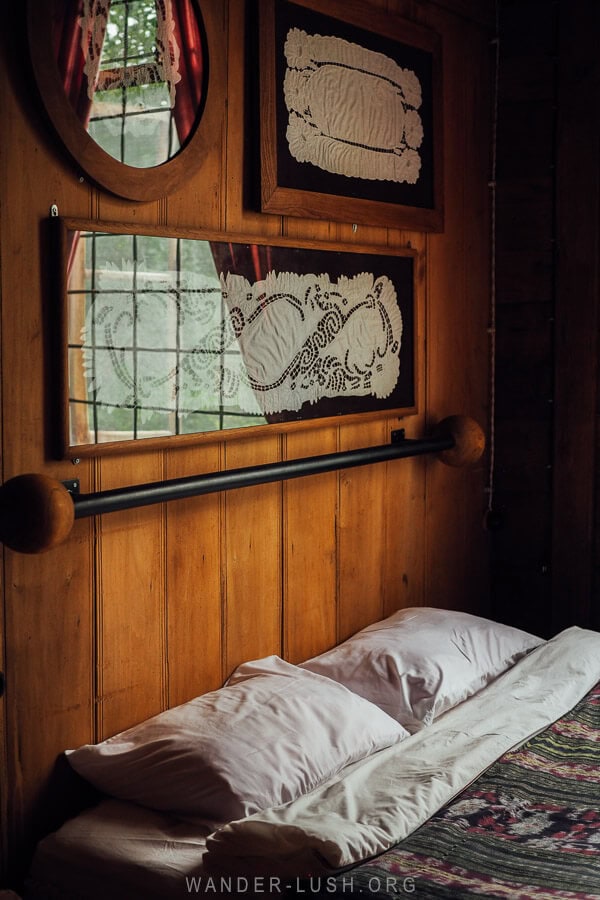
Misha’s Place (Ozurgeti): If you don’t have your own transportation or you want to stay in the centre of Ozurgeti for convenience sake, I highly recommend this Airbnb. Misha and Chika are very generous (and helpful) hosts with lots of local tips to share. The house is spacious and comfortable. Book here via Airbnb.
Chamo (Vakijvari): Also run by Misha and Chika, Chamo offers camping and a gorgeous cottage in a small village at the foot of Chokhatauri mountain. Book here via Airbnb.
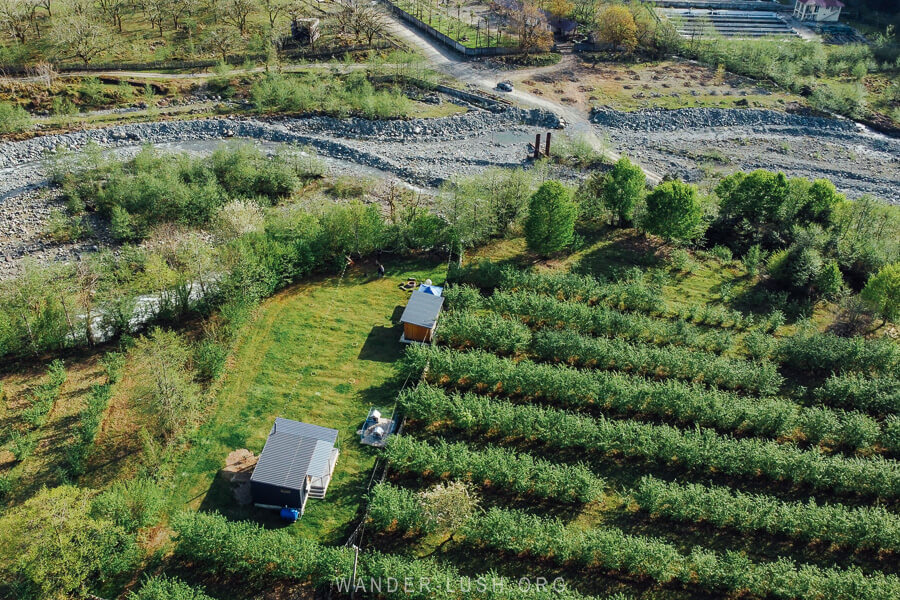
GiNA Shekvetili (Shekvetili): If you want to stay on Guria’s Black Sea coast, I highly recommend Shekvetili beach and GiNA, a simple and affordable hotel with clean rooms and friendly staff a few steps from the waterfront. Book here via Booking.com.
Map of Guria
Find all the points of interest, landmarks and restaurants mentioned in this guide on my free Guria Map. Click below to open the interactive Google Map.
(Notice how the shape of Guria looks just like a mini map of Georgia!)
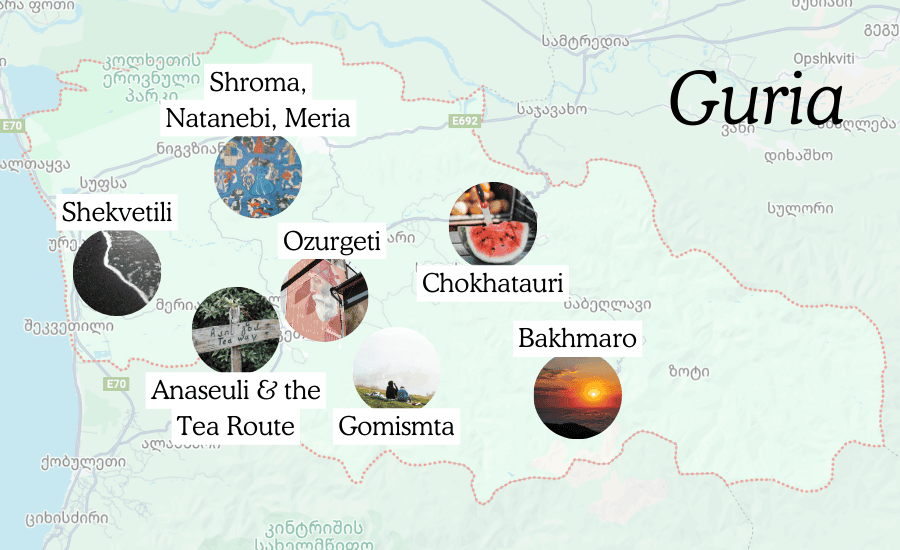
Things to do in Ozurgeti city & surrounds
If you only have a day or two for Guria and/or you are without a car, the best strategy is to stay local to Ozurgeti and explore the small city centre plus the old tea fields and new Tea Route.
1. Wander through the tea plantations in Anaseuli
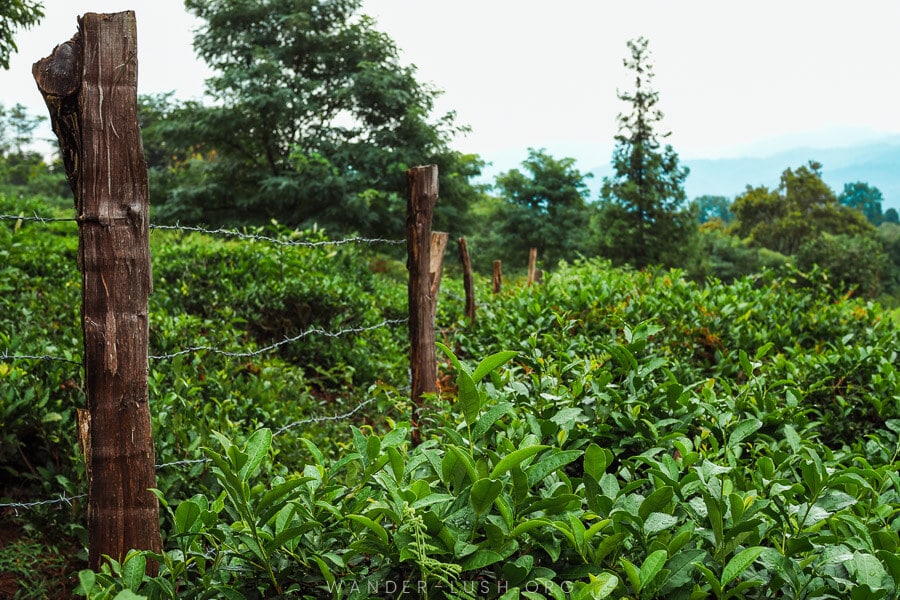
You can find tea fields large and small all over Guria. There is a particularly high concentration of plantations in Anaseuli, located on the south-western side of Ozurgeti.
This is the best place to see remnants of the old Soviet-era tea industry, including processing factories, an abandoned scientific research institute, and various workers’ housing complexes, all set in a vast landscape of tea fields.
The plantations themselves – numbered Plantation #1 through to Plantation #14 – are lush and overgrown. In some cases the untended bushes went wild after the collapse of the Soviet Union…
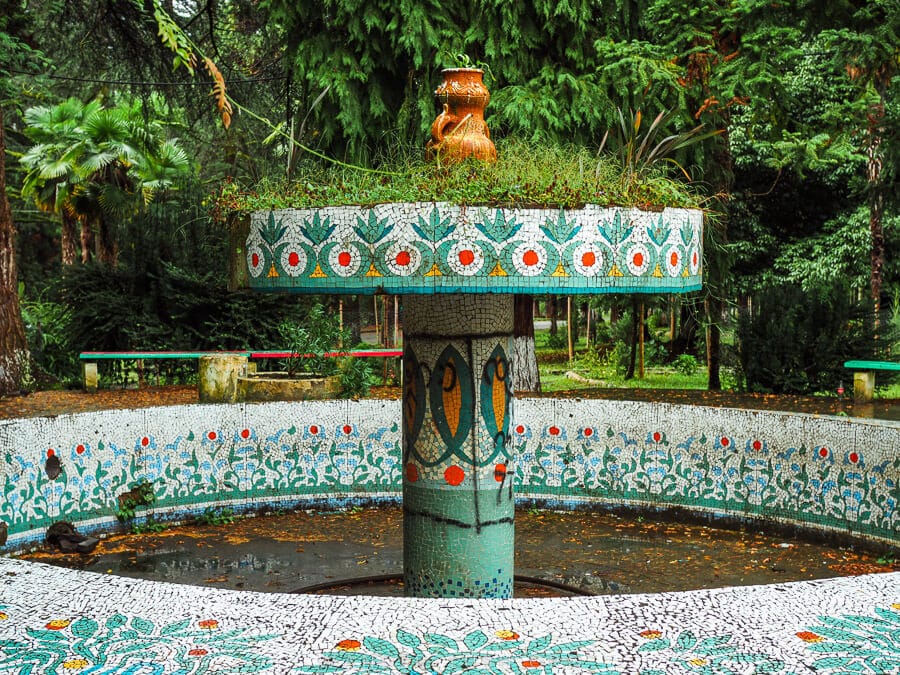
To appreciate Anaseuli’s significance, you first need to know a bit about Georgian tea.
Tea history starts right here in 1799, when Prince Mamia Gurieli – the last ruler of Guria Principality – smuggled the first Chinese plants into Georgia to endow his botanical garden (you can still visit the garden in Ozurgeti today – see the next section).
In the 1840s-60s, the Russian Empire took an interest in Georgia’s tea-growing potential and started to grow tea at an industrial scale. They couldn’t have done it without the guidance of Chinese tea expert Lao Jin Jao, who was invited to steer the fledgling industry. In 1900, his tea received a Gold Medal at the Paris Exposition Universelle.
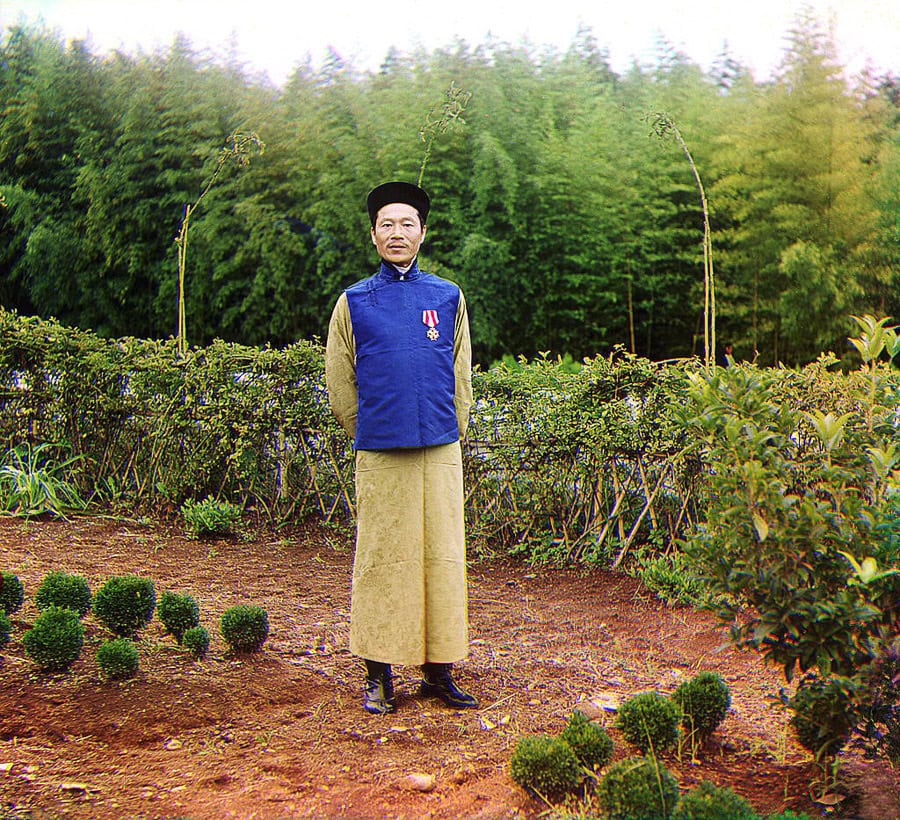
Under the Soviet Union, hand-plucking was replaced with mechanical harvesting so that by the 1980s, tea employed almost 200,000 people across 70,000 hectares of plantations and 25-plus factories.
At its peak, Soviet Georgia harvested 600,000 tonnes of tea leaves, making it the fifth-largest producer in the world.
Of course that all came to an end when the Soviet Union collapsed, taking the tea market and Georgia’s export links – and thousands of families’ livelihoods – down with it.
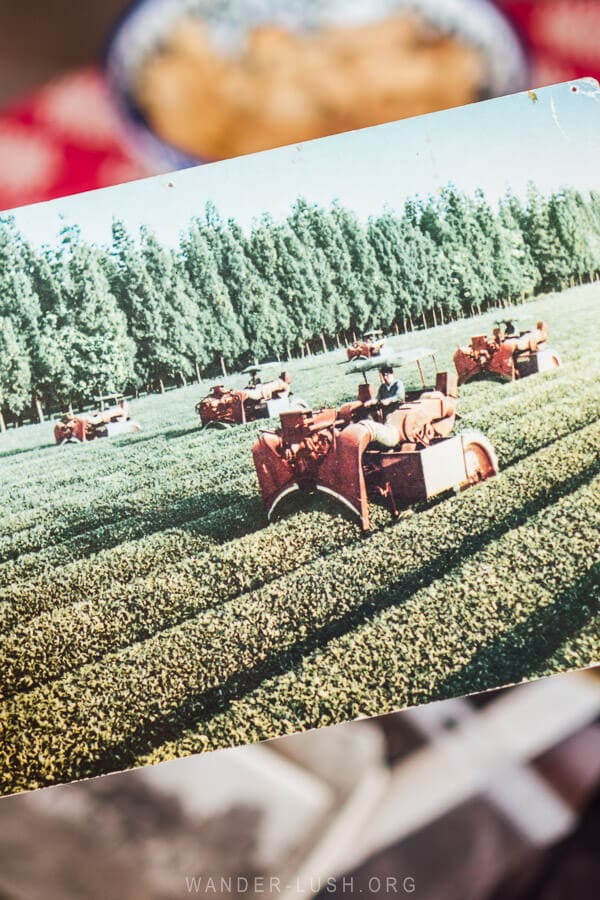
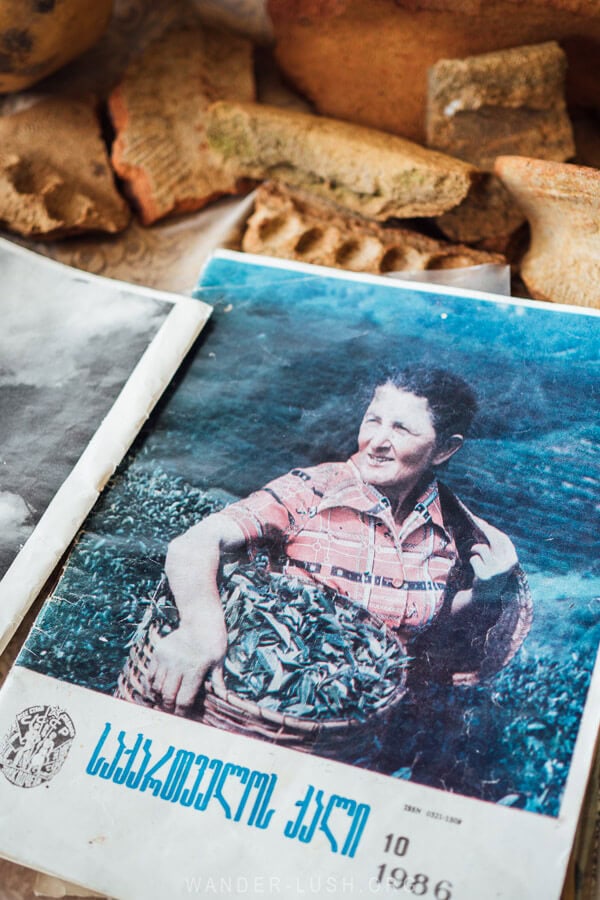
Anaseuli is a living memorial to Georgia’s tea heritage.
As you pick a path through the overgrown plantations, you can imagine how different it must have been when the fields were abuzz with workers.
Georgia was and still is one of the world’s northernmost commercial tea regions, and the country made a huge contribution to global research. Working from her laboratory in Anaseuli, Georgian scientist Ksenia Bakhtadze developed 16 hybrid varieties of tea that could withstand frost and produce a high yield.
Researchers from across the world travelled to Anaseuli to learn about the latest in tea cultivation. The tea industries in neighbouring Turkiye and Azerbaijan both got their start thanks to lessons learned in Georgia.
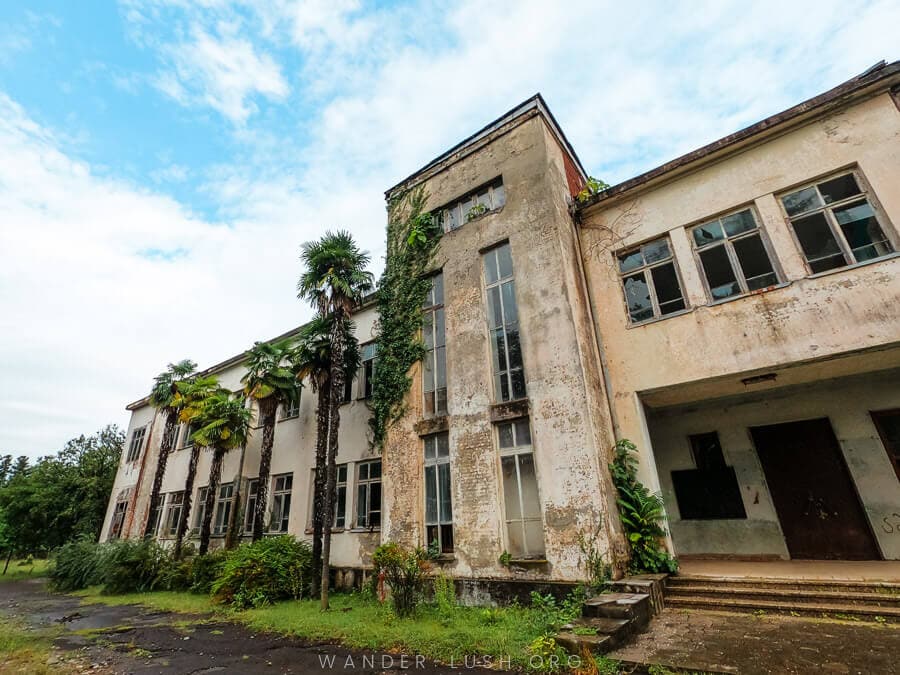
Now the Tea and Subtropical Crops Institute lies abandoned and in a state of disrepair. It should be revived as a monument to Bakhtadze’s work and Georgia’s contributions to tea – but I’m not holding my breath. Rumours that Lao Jin Jao’s house in Chakvi on the Adjarian Coast will be restored to a tea museum have been floating around for years.
There are a few beautiful mosaics and fountains on the Anaseuli Institute grounds. If you’re into urbexing, you can venture inside.
Decades of research, thousands of hours of passion and dedication strewn across the floor like trash. It’s a very sad sight indeed.

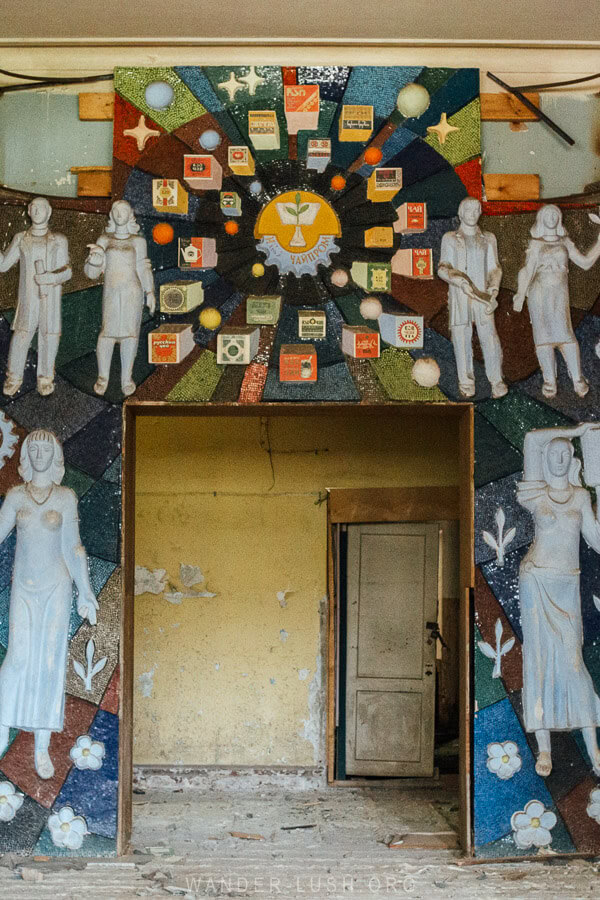
Families still live in the Anaseuli housing estates, but these days they are more likely to farm hazelnuts, until recently a much more profitable crop. Many of the old tea fields have been razed and replaced with neat rows of hazelnut trees.
There are always people around, but they never seem to mind curious tourists taking photos.
The tea fields open up just beyond the Institute complex. It’s simply a matter of following the winding dirt roads up and over the hills.
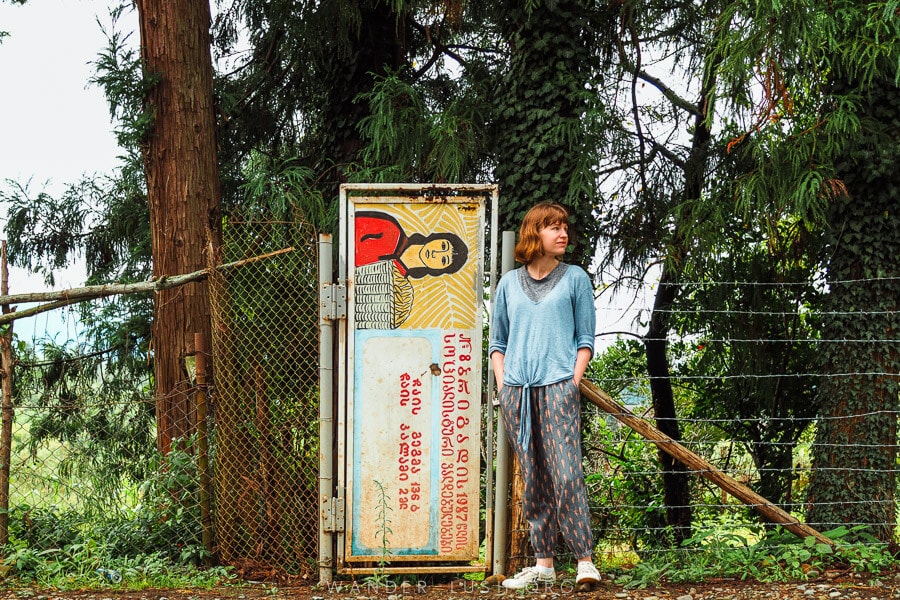
One of several dozen processing and packaging factories that existed here, the Anaseuli Tea Factory is still working today.
Tours of its Soviet-era equipment are available but should be prearranged in advance by phone. I have not been yet, but having visited Soviet-era factories in Zestafoni and Rustavi, it is top of my list for my next trip to Guria.
2. Travel the Tea Route & do a Georgian tea tasting
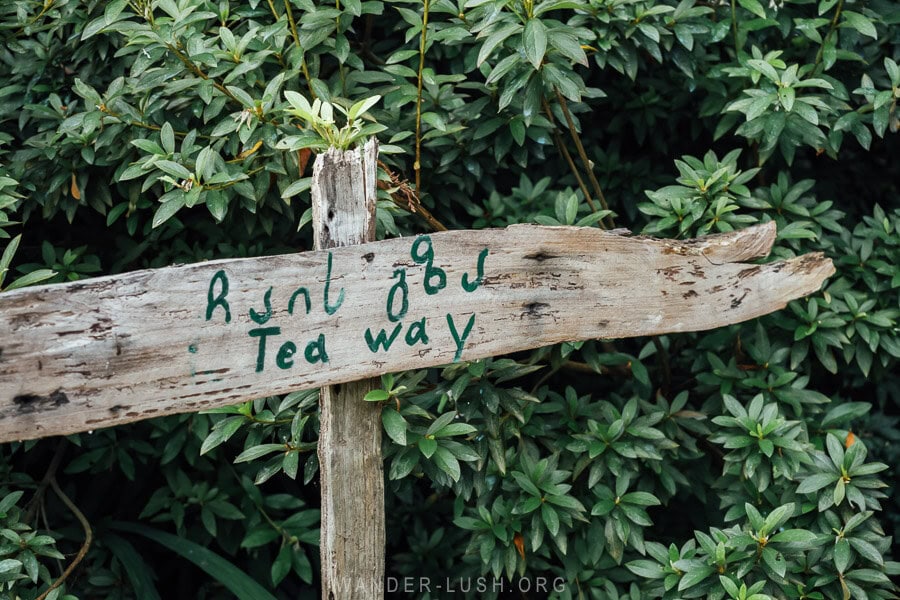
Georgia’s tea connection is not all doom and gloom. The industry is currently undergoing something of a revival, with dedicated entrepreneurs reviving an artisanal tea sector and pioneering tea tourism in Guria.
They are led by the Georgian Tea Producers Association. One of my favourite things to do in Tbilisi is visit the Bitadze Tea Shop, a tiny museum-shop in Sololaki run by Shota Bitadze and his son, Giorgi (seen roasting green tea in the photo below), who head up the Association.
Whilst in Guria, if you want to go deeper on tea history – and of course taste the real thing – then you should next venture along the Tea Road. Half-a-dozen small-scale producers offer tea-themed tours, degustations and home-cooked Gurian meals to visitors eager to immerse themselves in the region.
These include:
Teni Tea and Komli are my two favourites so far.
Teni Tea (Kveda Bakhvi, 15 minutes from Ozurgeti)
Teni Tea is special because it was the first Soviet-era plantation in Georgia to be rehabilitated. Owner Dato Tenieshivili is a bonafide tea master – he was the very first member of the Tea Growers Association and is now the Regional Head for Guria.
When Dato was growing up, his family worked on a collective tea farm. In the 1990s, he salvaged old Soviet-era equipment – including a wooden tea roller that he rigged to work off hydropower – and began producing small amounts of high-quality tea.
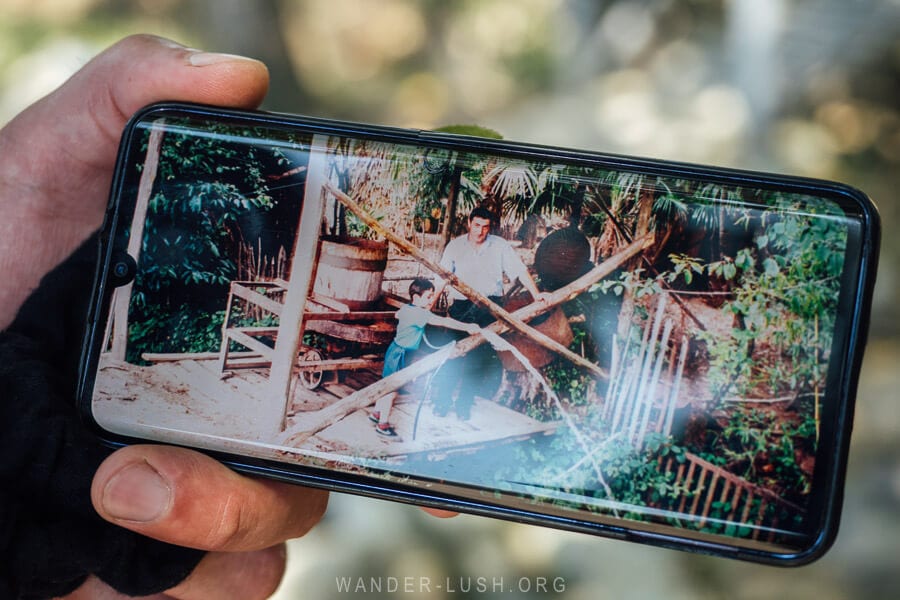
Things grew from there, and today Teni Tea manages three fields containing heritage 80-year-old bushes. They use organic methods to produce fine Chinese-style green, white and black tea.
Many of the lovely pickers who work the fields here are locals who used to be employed on the Soviet plantations.
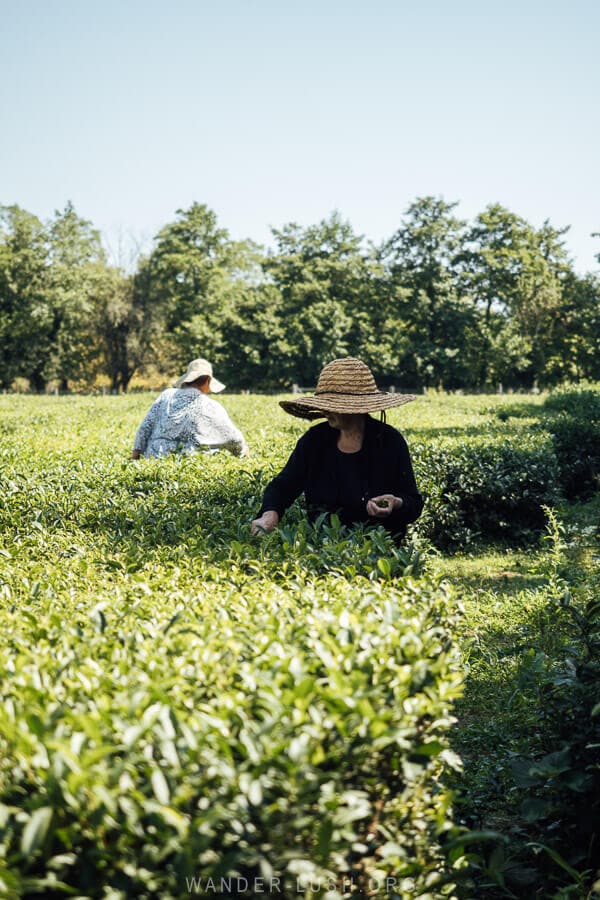
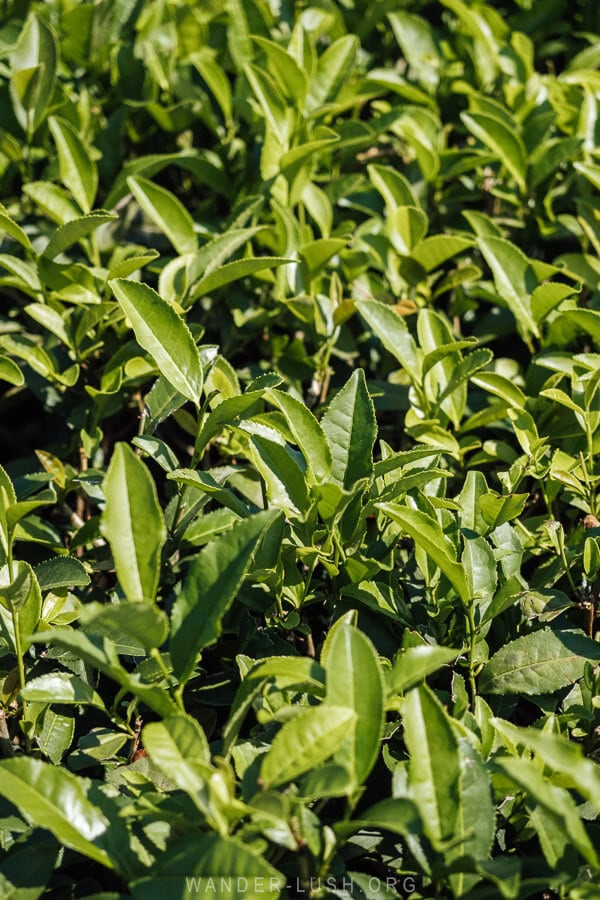
We had a wonderful tour of Teni Tea courtesy of Dato’s son, Gabriel Tenieshvili.
Over the course of around two hours, visitors can pluck, roast, dry and drink green tea – meaning you can see the entire process from field to cup, which is pretty remarkable.
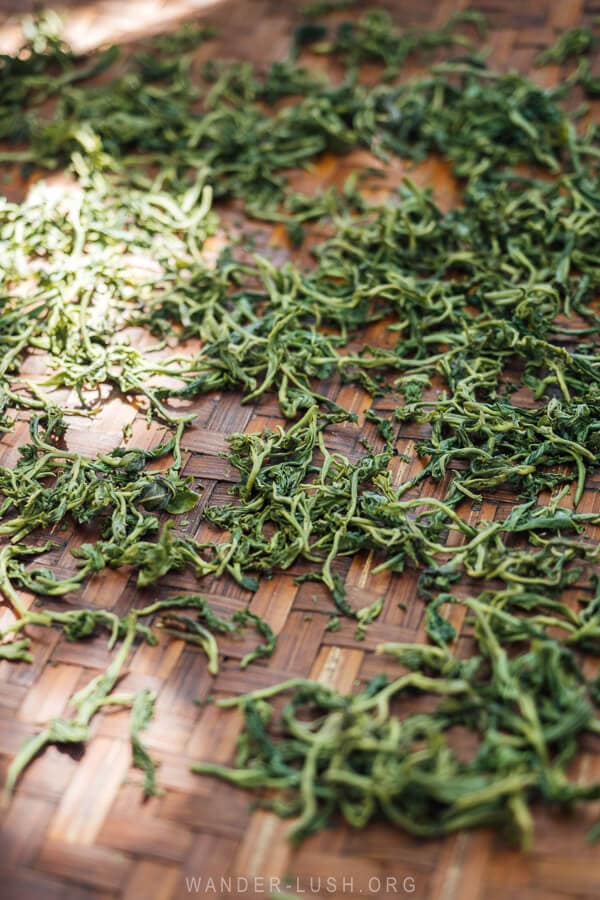
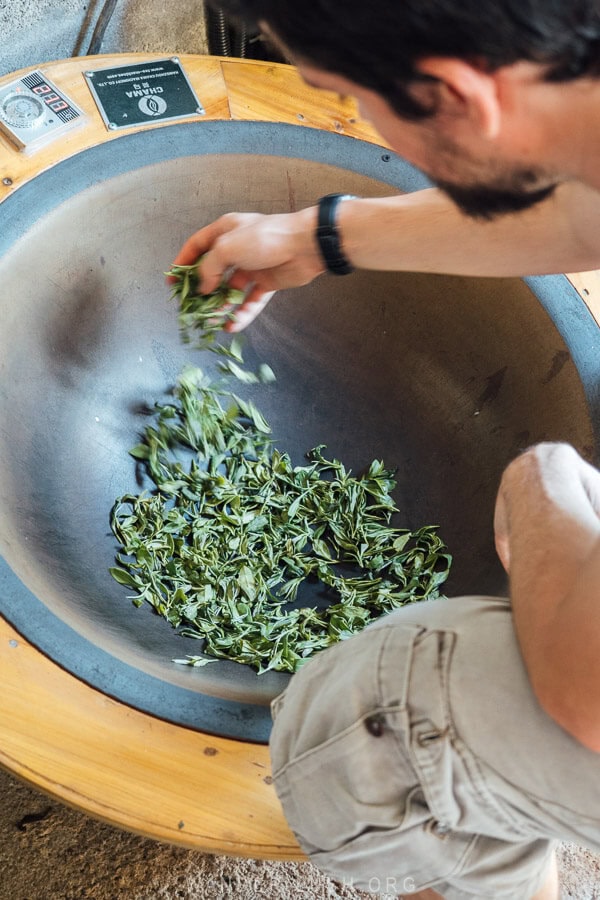
The verandah of the Tenieshvili family home has been converted into the loveliest tea degustation room you can imagine. Whilst sipping tea, you can also taste homemade preserves and snacks – including their signature dried mandarin.
Gabriel’s wife, Nino, is a phenomenal cook and can prepare a full lunch on request. Her Guruli ghvezeli (a crescent-shaped khachapuri filled with cheese and hard-boiled eggs) is out of this world.
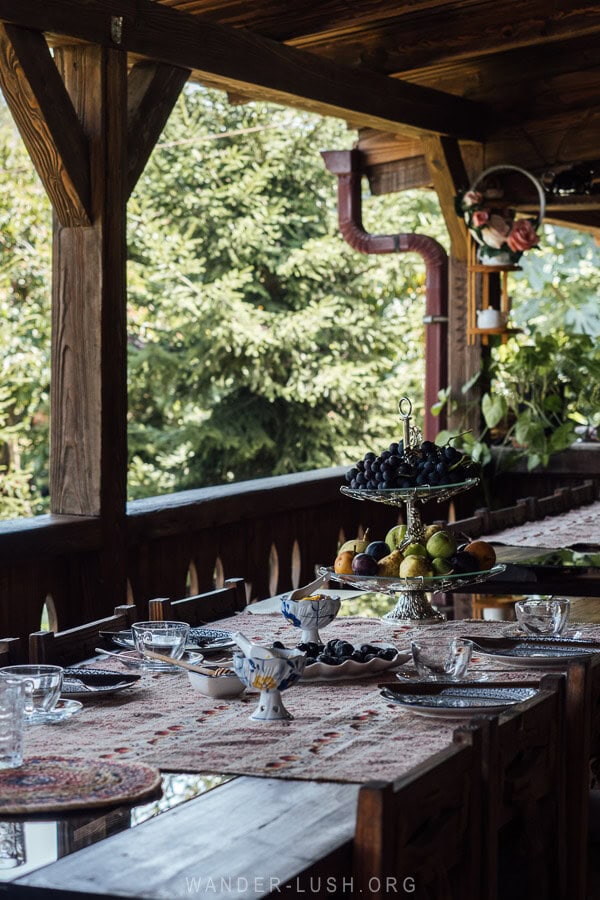
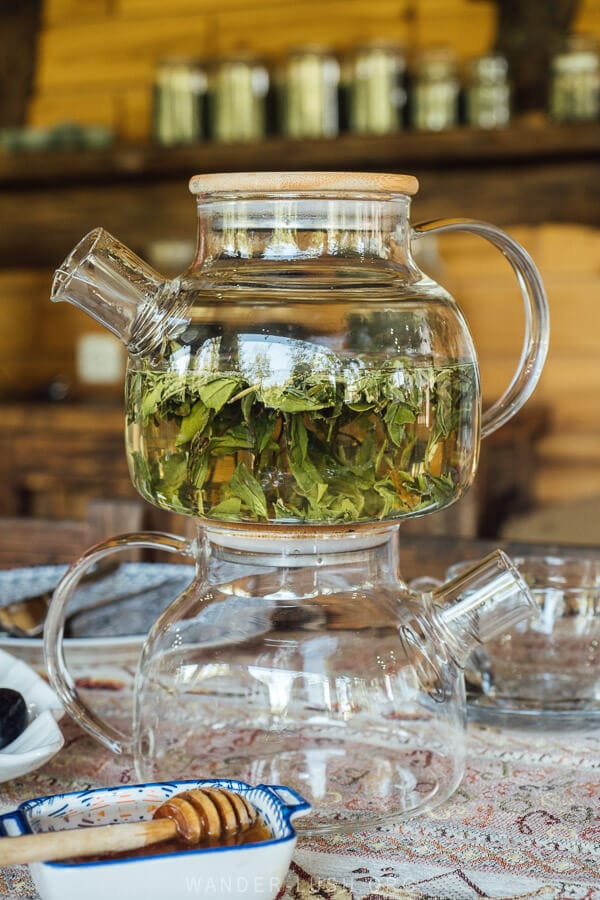
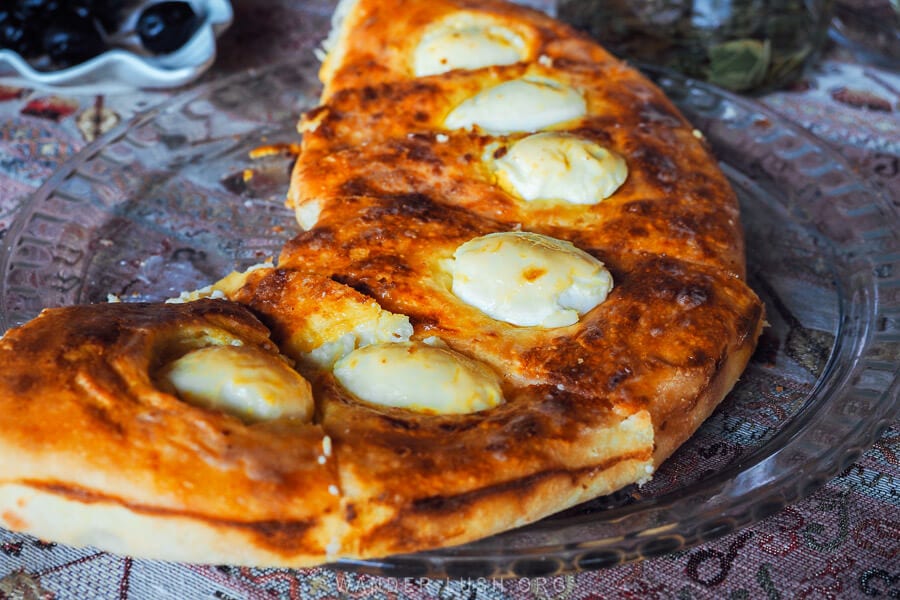
Tours, degustations and meals should be pre-booked a few days in advance. Contact Gabriel via Facebook or phone to arrange a time.
If you are driving, ignore Google Maps and approach from the east instead via the Bakhvi Road (the turn-off for the house is located here). If you don’t have your own car, Gabriel can help to coordinate transport from Ozurgeti.
Komli (Tsitelmta, 10 minutes from Ozurgeti)
Run by three generations of women, Komli is another terrific venue for a tea tour and degustation. This is the first tea farm I visited in Guria, and it will always have a special place in my heart.
The Megreladze family has also been involved with the tea industry for generations. They keep a small tea field in their back garden.
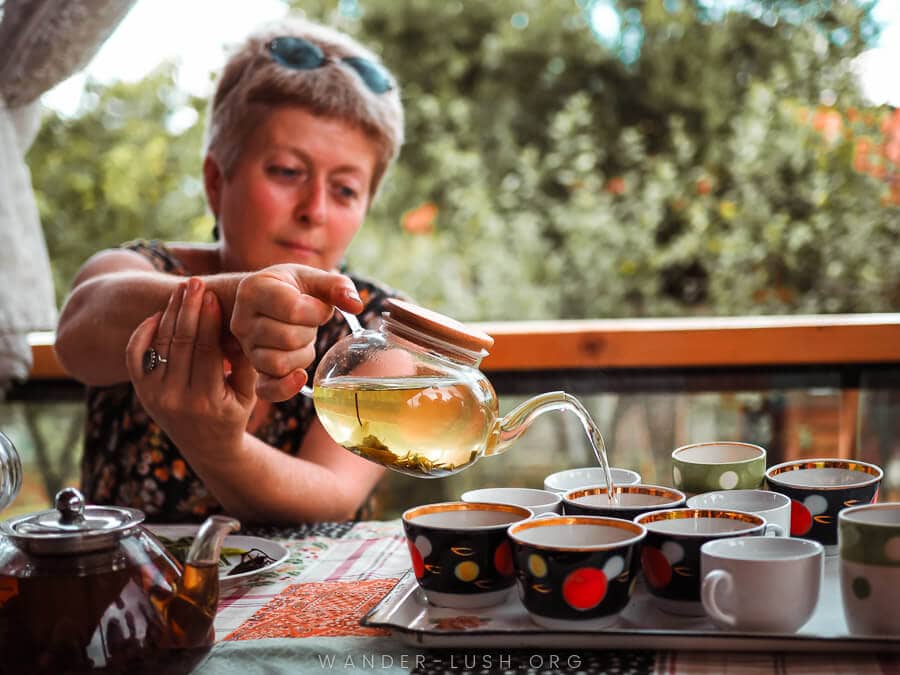
The property also has a meandering stream, a bamboo forest, and a Diogenes barrel that has been converted into a cubby house! You can rent it for the night, or stay in one of the rooms inside the family home (Komli doubles as a guesthouse).
This place is a wonderland and is great for kids.
Hostess Lika (pictured above) knows everything there is to know about tea in Georgia. After touring the fields, visitors can sit down for a tasting of green and black tea on the veranda of the family’s wooden oda house. Meals are also available.
Much of her knowledge was inherited from her mother, Meri (pictured below), who had a career as a tea scientist.
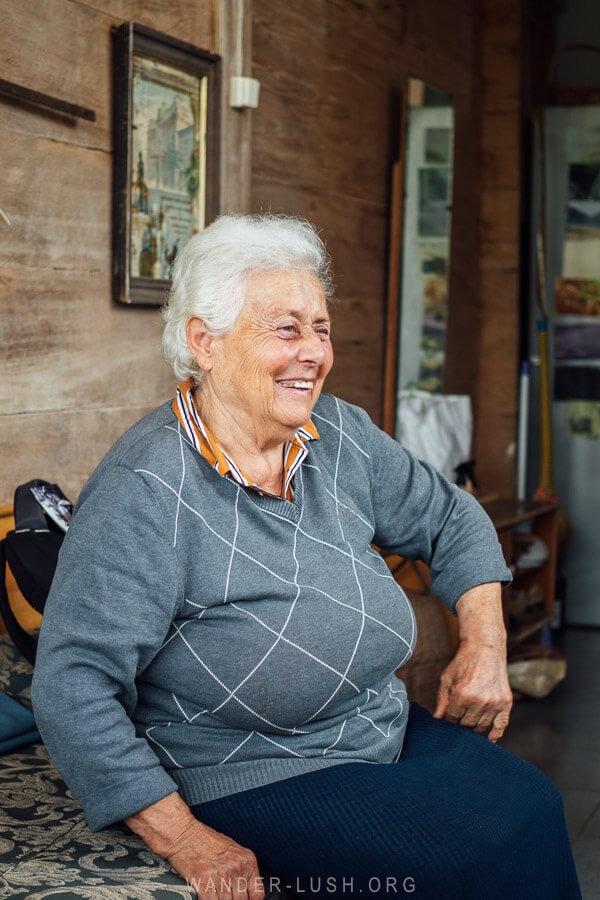
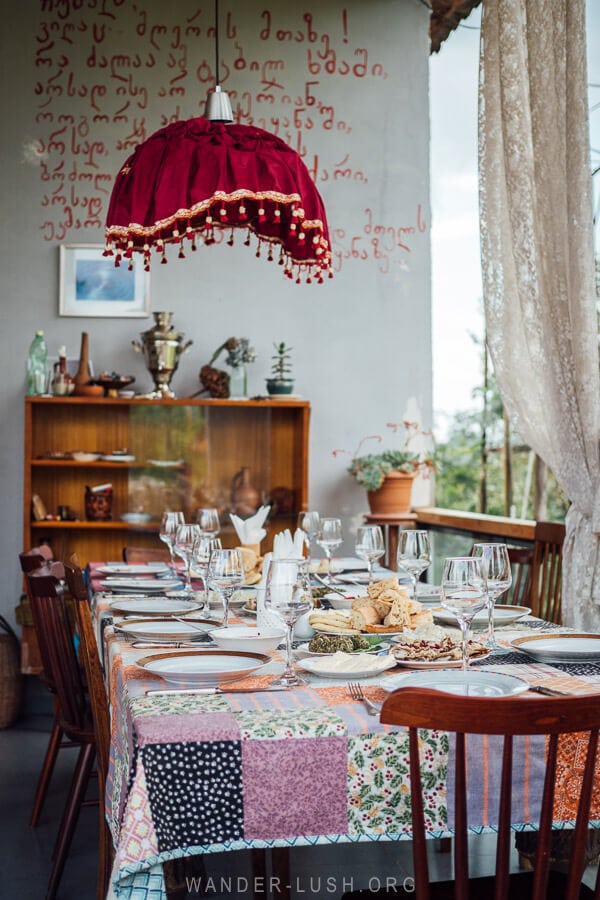
Visit the Komli website to browse the different offerings and prices. Bookings should be made a few days in advance.
To reach the farm from Ozurgeti, follow the road through Kviriketi. Taxi transfers can be arranged through Komli.
3. Visit the eerily beautiful Shemokmedi Monastery & cemetery
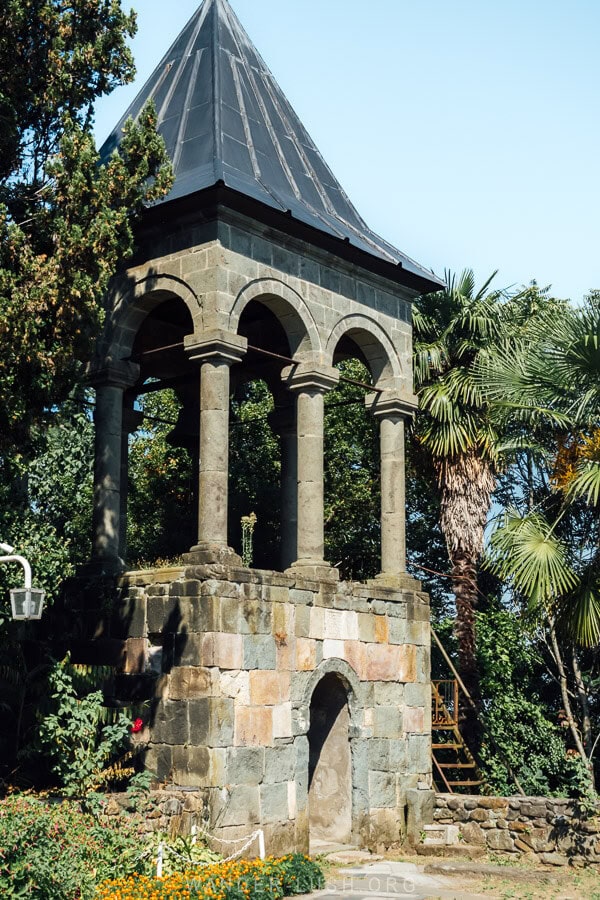
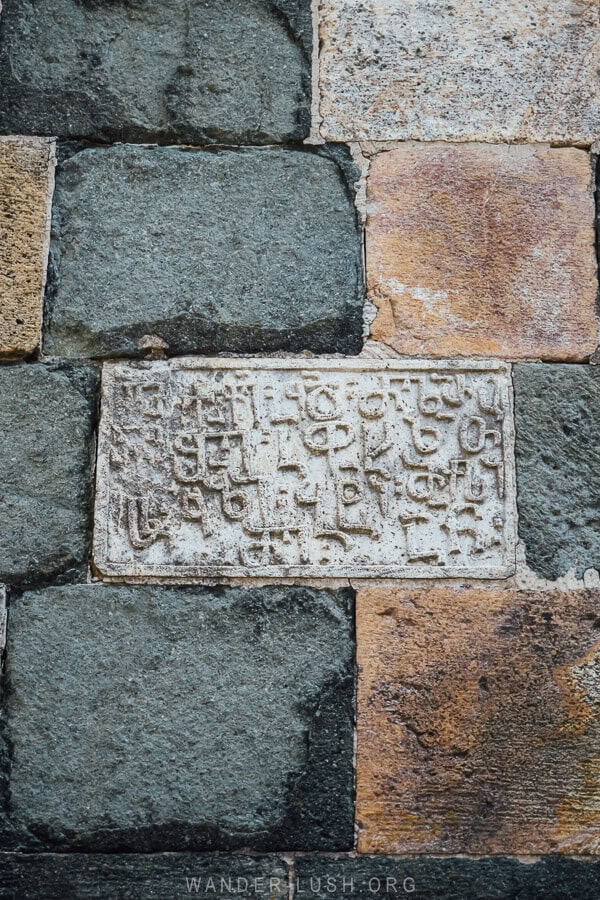
Like every region in Georgia, Guria has plenty of noteworthy monasteries and churches, each with an interesting story. If you only have time for one, make it Shemokmedi Monastery.
Located 8 kilometres southeast of Ozurgeti (close to Komli), Shemokmedi was constructed in the 12th century and was the burial ground for the Gurieli dynasty. According to some sources, it used to be the ‘wealthiest’ monastery in all of Georgia, and once contained a library of important manuscripts, relics and other treasures. Much of the collection is now housed at the Georgian National Museum in Tbilisi.
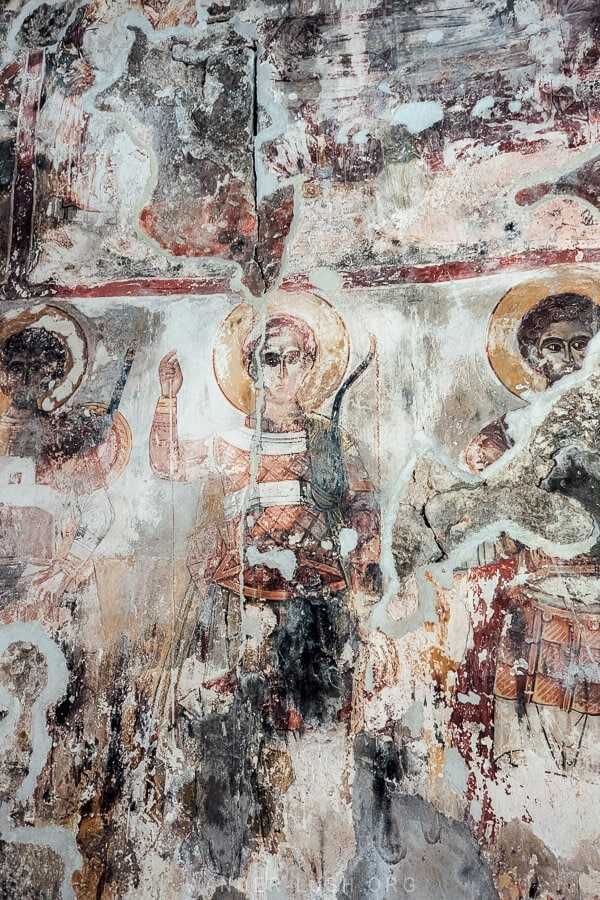
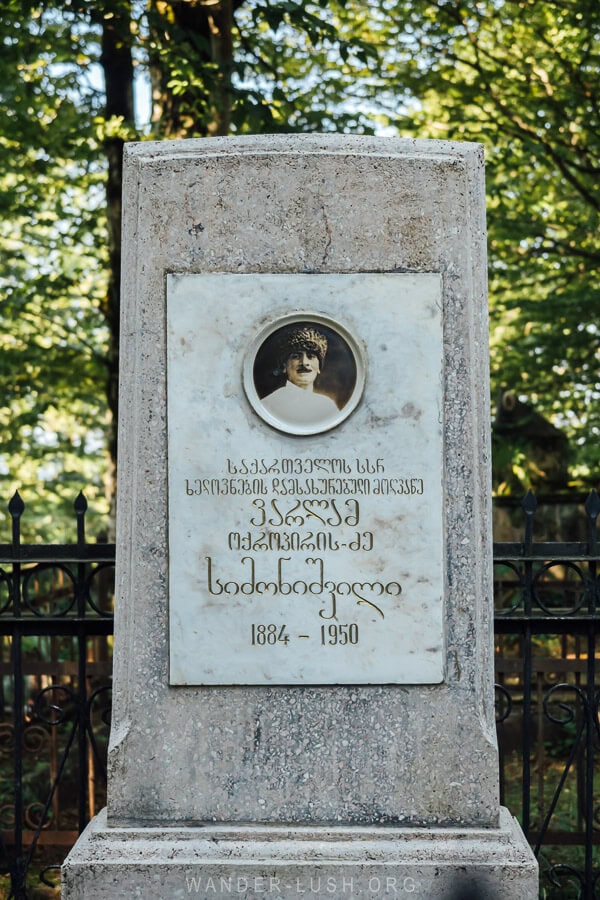
There is a new (quite steep but sealed) road up to the monastery. Take in the panoramic views from the lookout near the parking lot, then walk up to the main sanctuary via a path that leads you through the beautiful Shemokmedi Cemetery. Between the palm fronds, you will see some remarkable headstones from the 1930s and 40s, as well as mini mausoleums complete with decorative gutters and downpipes.
The monastery complex consists of a unique 16th-century bell tower and two churches, all constructed from blocks of mottled grey and pink stone. Look out for the 11th-century inscriptions on the facade.
The grounds are always open. Previously I have found the church itself locked, but on my most recent visit, the caretaker arrived to open the doors at around 10.30am. She was very friendly and welcomed me inside to photograph the faded frescoes.
4. Get a view from Ekadia Church of St. George
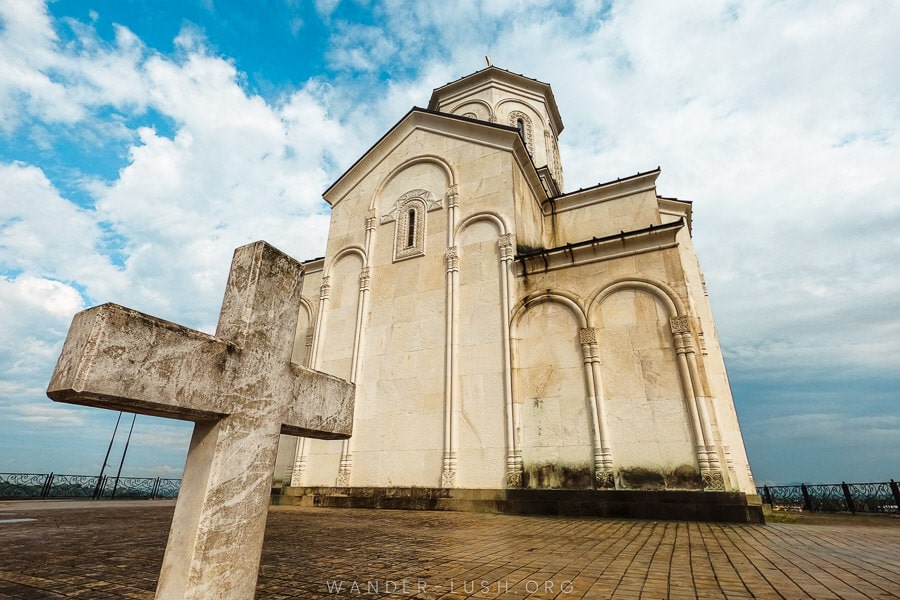
Another church with a view, this time closer to Ozurgeti, St. George’s is a small Orthodox church perched on a hill on the south-western edge of the city.
Built on the site of an old medieval church, it sits above the Buzhuzhi River, which collects two smaller rivers that run through the centre of the city.
Verdant hills unfold in every direction, studded with the red roofs of one and two-story houses, the occasional Socialist-style monolithic apartment block sticking out like a sore thumb.
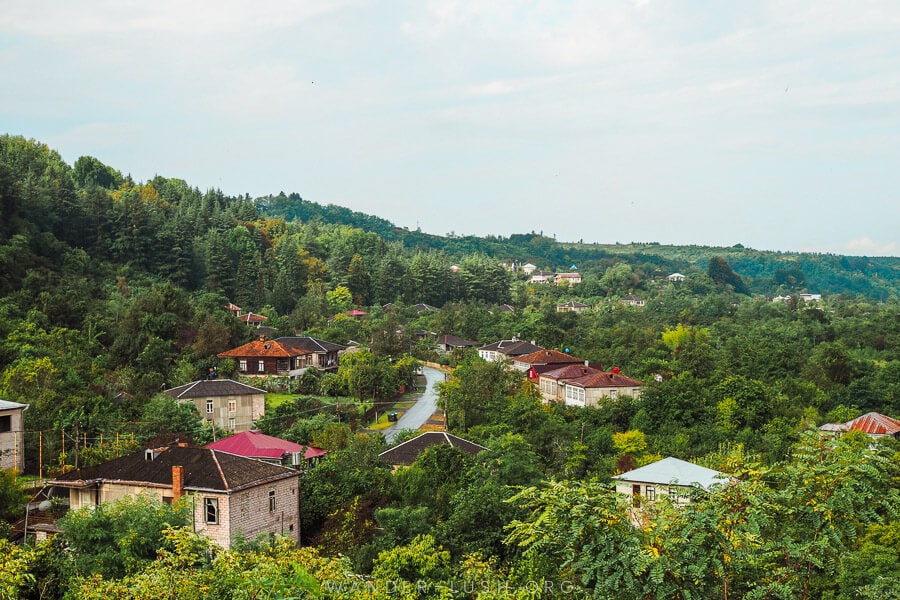
As well as a view, you can get a feel for Guria’s climate from this elevated position. I wandered around the churchyard for about 20 minutes and in that time watched the sky morph from thick violet storm clouds to piercing blue.
5. Shop for hazelnuts & straw hats at the Ozurgeti Farmers’ Market
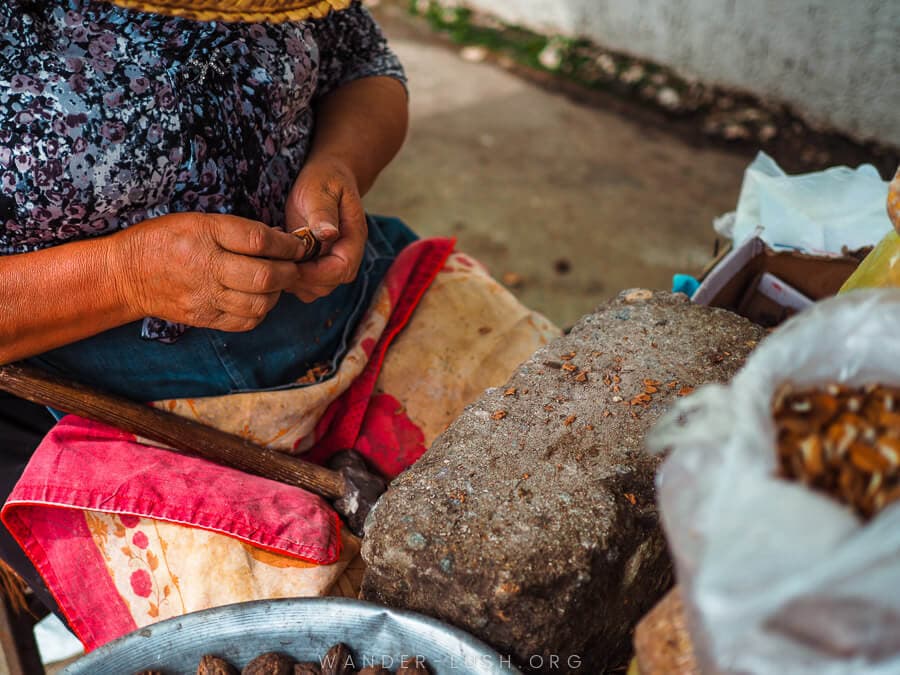
Ozurgeti’s bazaar is a vibrant display of local produce and a hive of activity. This being Georgia’s main hazelnut-growing region, you can see huge bags of unprocessed nuts being traded from rows of colourful shops at the front of the market.
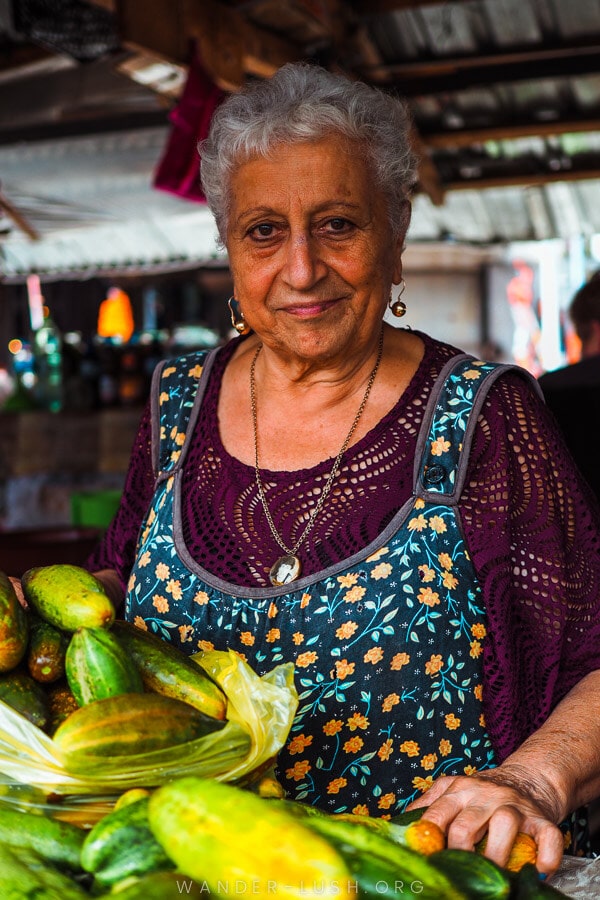
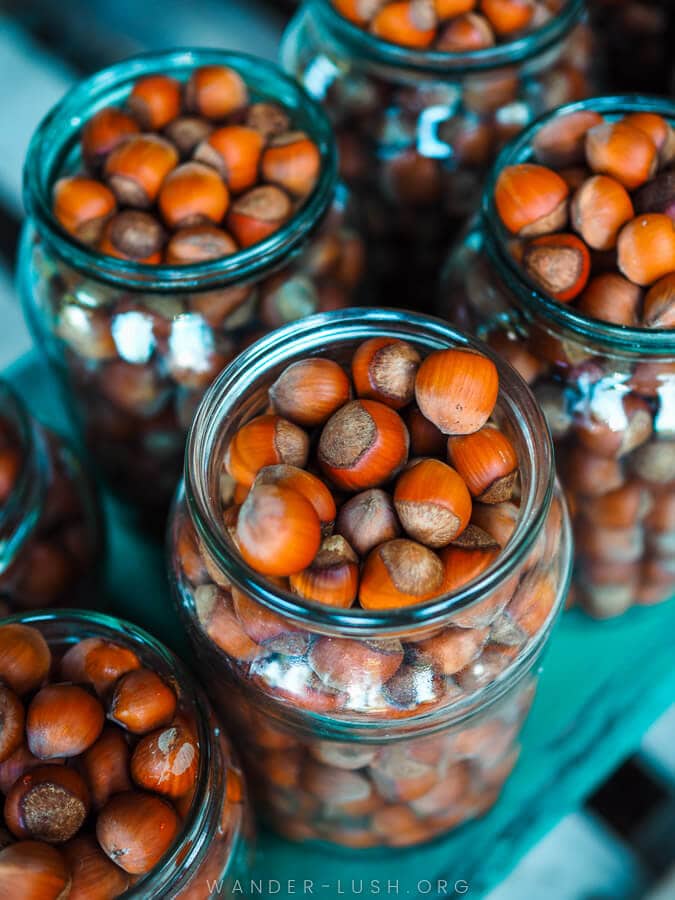
Inside, a maze of outdoor and undercover stalls sell fresh veggies and spices.
Woven wide-brim farmers’ hats and tea-picking baskets can be found at the little shops in the side streets. I have a pair of each which I proudly display at home!
Foreign faces are few and far between, so expect lots of attention from stallholders and food samples as you walk the rows.
The market is open daily from early until around 6pm. If you love markets, be sure to time your visit for the Sunday market in Chokhatauri, north-east of Ozurgeti, which takes place on Sunday mornings (see the next section).
6. Take a stroll around Ozurgeti city centre
When I first visited Guria back in 2020, Ozurgeti felt like a ghost town. This is definitely one of the smallest and quietest of the regional capitals I have visited in Georgia. I only say this to manage your expectations: Don’t come expecting a Kutaisi or even a Zugdidi or Telavi.
But – Ozurgeti has its charms, and it has certainly changed in the past five years. The city is walkable, with lots of green space, and an interesting mix of Soviet architecture.
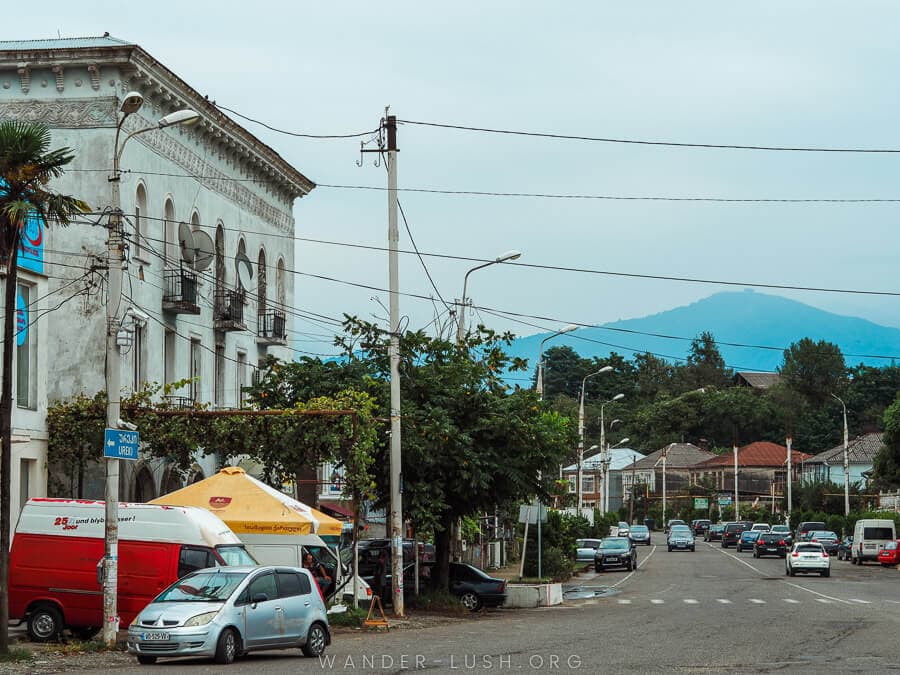
A short stroll through town will introduce you to several notable landmarks.
The most recognisable building in Ozurgeti is the Dramatic Theatre, with its imposing facade of high arches and a statue of Gurian-born film director Alexander Tsutsunava out front. It is the second-largest theatre building of its kind in Georgia and along with Ozurgeti Railway Station, one of the city’s architectural gems.
The theatre recently reopened after extensive renovations – the interior looks quite spectacular. I am still trying to get inside so if you have any leads, please let me know!
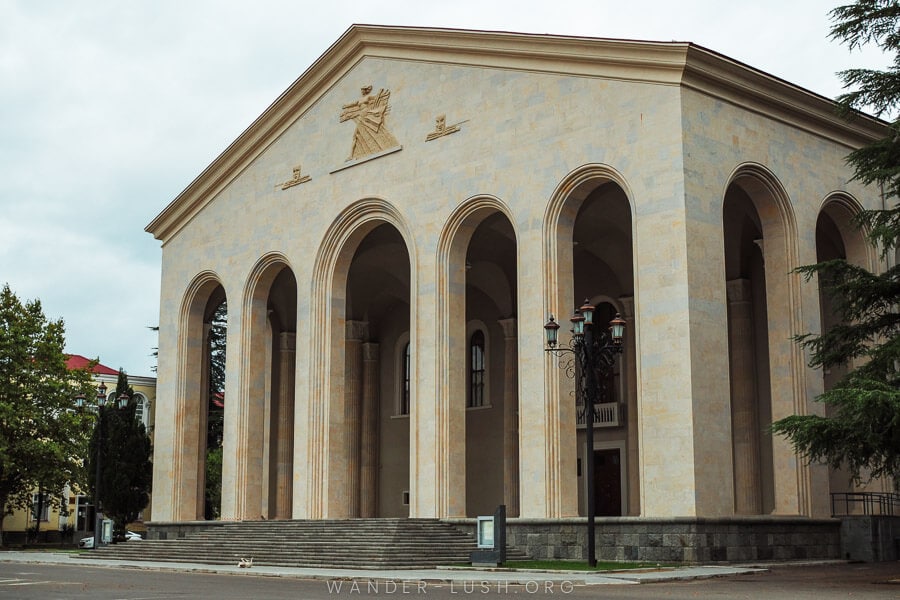
The building next door to the Public Service Hall is labelled as both a Folklore Centre and a History Museum on Google Maps. I don’t know the true function because I have never been able to get inside.
The Museum Association of Ozurgeti Municipality does have an active Facebook Page – and if the photos they post are of this building, then it does look very neat. I will have to try to get inside on my next visit.
It is still worth stopping by to see the wonderful bas-relief sculpture on the exterior of the building. It is reminiscent of the panno on the outside of the Green Bazaar in Kutaisi.
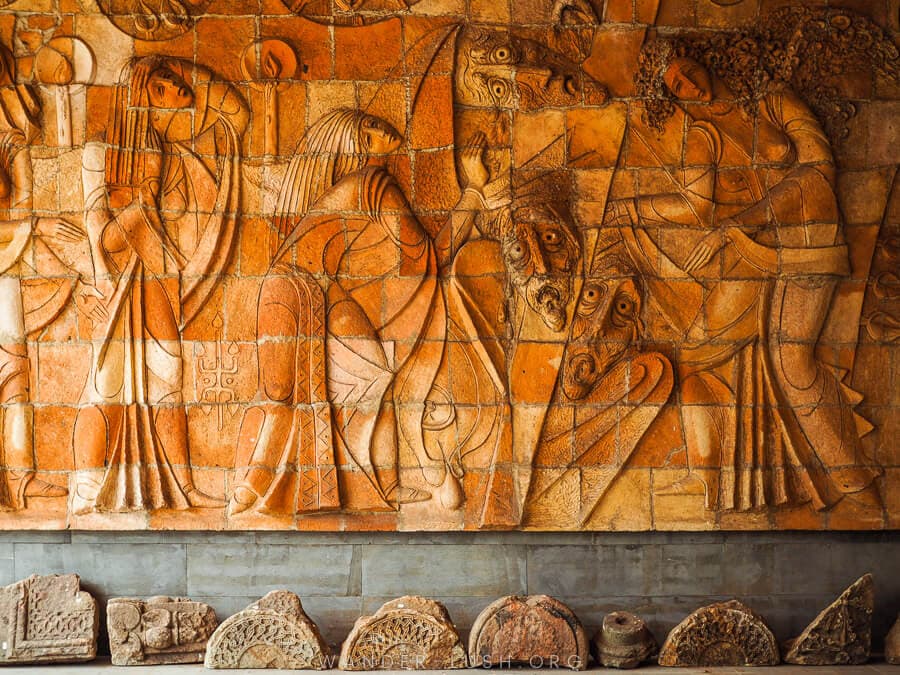
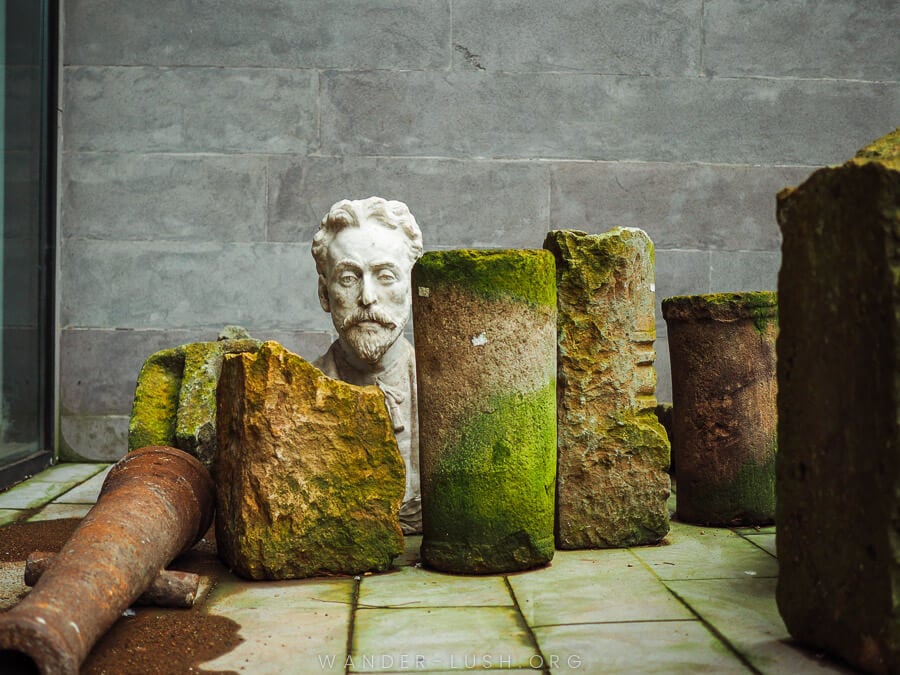
Next to the museum and directly opposite the theatre, one of Ozurgeti’s oldest monuments, Gurieli’s Bath, is not exactly easy to spot.
When I read about the ruins of a two-story Byzantine bathhouse having been uncovered in the centre of Ozurgeti, I was expecting to find a large excavation site. Unfortunately, the city’s main police station is adjacent, which I’m guessing has made things a bit tricky.
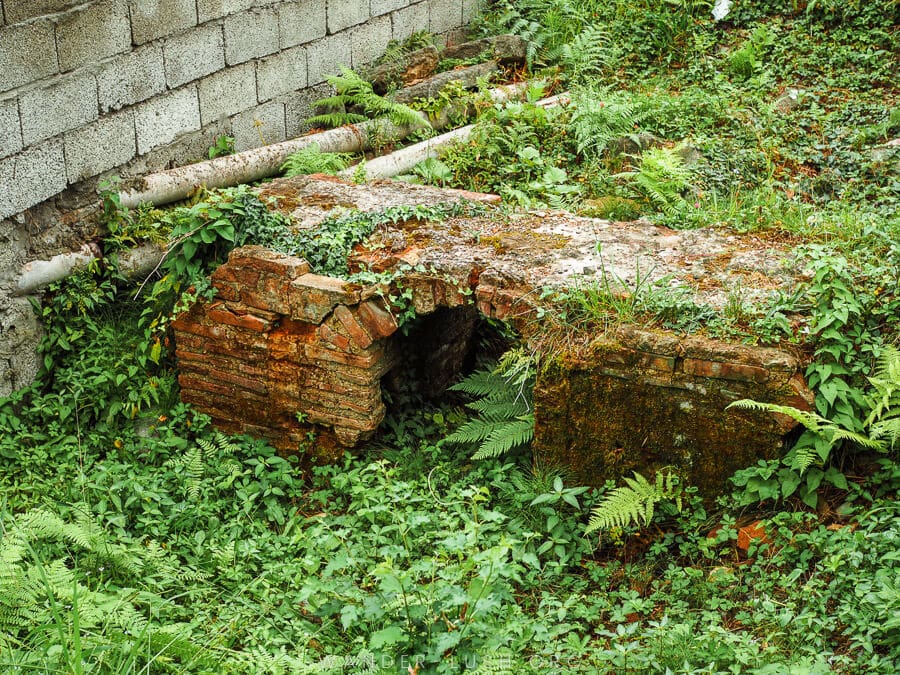
The two-story bathhouse is thought to have been constructed for private use for the region’s Gurieli rulers. Behind the police carpark, unsigned and quiet hidden away, you can see the remnants of the structure in a tiny open-air pit.
All you can really make out is the foundations of a room or two and a small section of arched brickwork. You’d be forgiven for walking past the site and not noticing it at all.
On the next block north you will find the Platanus Garden. Formerly a private royal garden, it was planned out by Scottish landscaper Jacob Montague Marr in the 19th century at the request of Mamia III Gurieli, the Prince of Guria.
Amongst the array of exotic botanicals you could find here were Georgia’s first ever Camellia sinensis tea plants.
Today the public park is a bit unkempt, but the century-old plane trees still provide shade to the pretty walking paths and benches arranged around fountains.
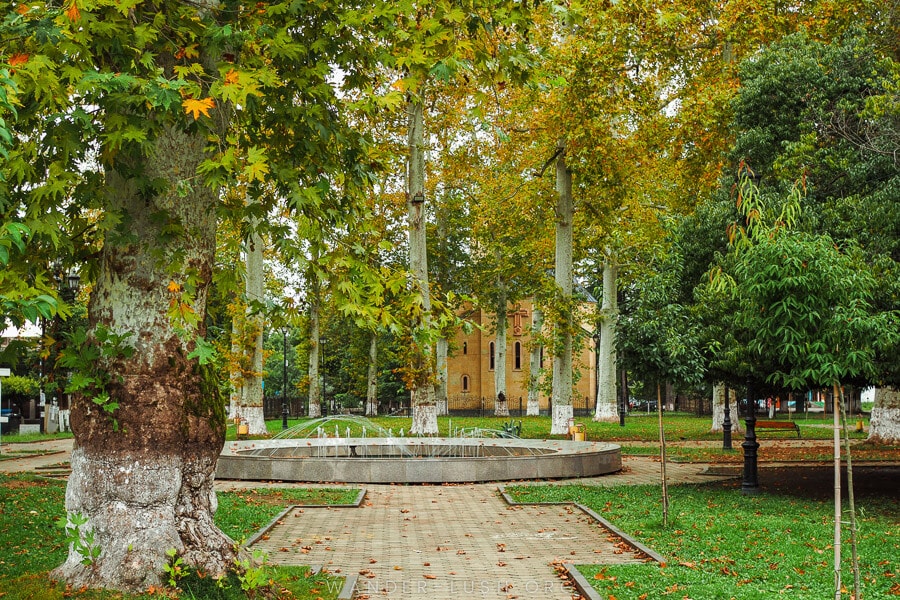
Ozurgeti’s main church, the Assumption Cathedral, sits in the centre of the garden alongside a war memorial. I once celebrated Easter Mass here.
When you reach the western end of the park you will see a stately building on the opposite side of the street. The Gurieli Palace was built in the 1860s as a dynastic residence and is the oldest building in the city. It now belongs to the Orthodox church.
Next door, the Ekvtime Takaishvili Archaeological Museum-Reserve is set back from the street inside a traditional oda house.
Cross the road at the southwestern corner of the park and you will notice several Soviet-style apartment buildings. There is an elevated concrete terrace that you can walk out onto for a view of the streets below, and a big set of stairs you can use to get back down to the market area.
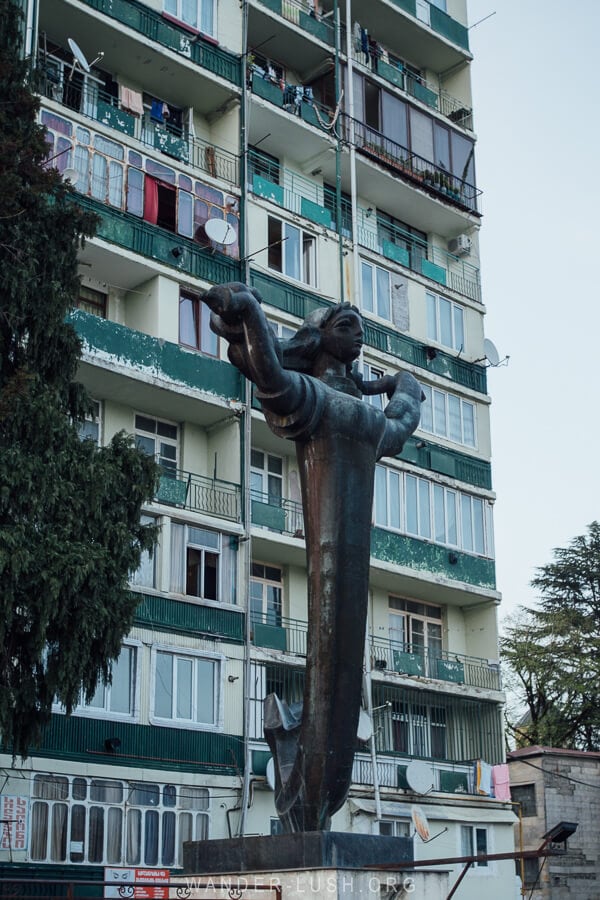
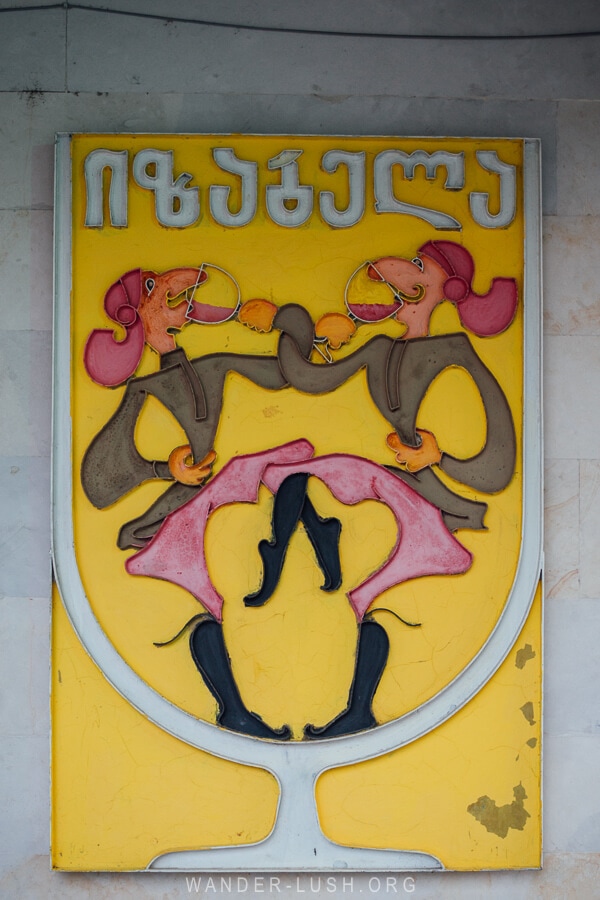
Amongst the shops, there is an old (still working, I think) Kodak film studio and a bar called Izabela that has the most wonderful sign out front (pictured above).
In the middle of the complex, a curious sculpture of a mermaid-like figure stands atop a huge dried-up fountain. I would love to know the name of the work and the artist – if you have the details, please drop me a comment below!
7. Photograph Ozurgeti street art
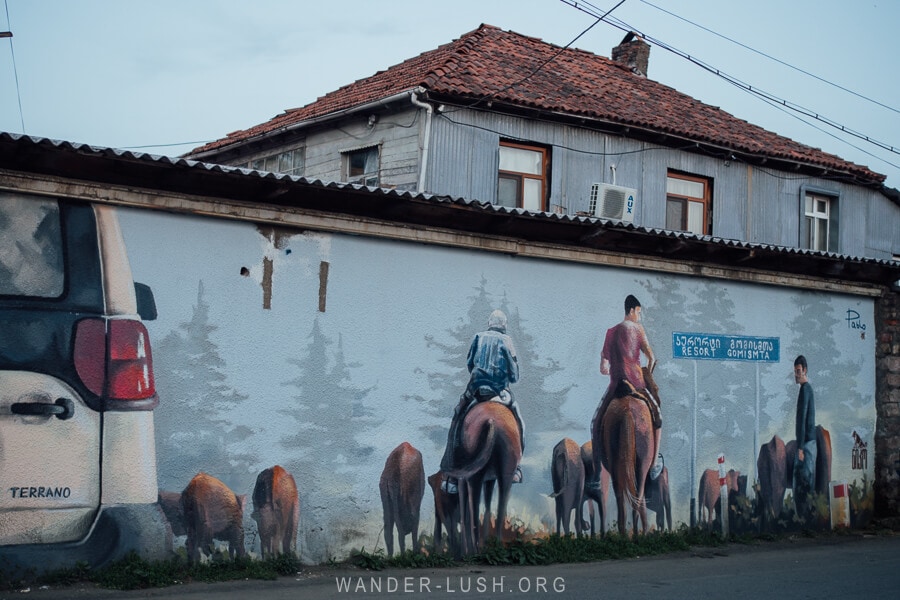
What Ozurgeti lacks in other attractions, it makes up for with a huge number of fantastic street murals.
Most have popped up in the past three years and were created by Georgian and international artists under the Niko Project. Each work reflects a different aspect of Gurian life and culture.
I have counted six murals in Ozurgeti plus one large-scale mural in the village of Chanieti, which is worth travelling for!
In order of appearance below:
- ‘Resort Gomismta’ by Georgian artist Giorgi ‘Pablo’ Kalandarishvili (2021), depicts a group of horse riders on their way up to Gomi Mountain (pictured above).
- ‘Tsitsa and Tsindali’ by Georgian artist Masholand (2023), depicts a woman and a kitten surrounded by tomatoes, walnuts and mandarines.
- ‘Abdali’ by French artist Primal Graphic (2022), depicts a bearded man dressed in Georgian traditional costume chokha.
- ‘Dancers’ by French artist Arkane (2022), depicts traditional Gurian dancers.
- ‘Astronaut Girl’ by Georgian artist Tamoonz (2021), depicts a female astronaut.
- ‘Three Elderly Gentlemen’ by German artist Matthias Mross, depicts a melancholic scene. Find it on the former Ministry of Education building in Chanieti village, 7 km from Ozurgeti.


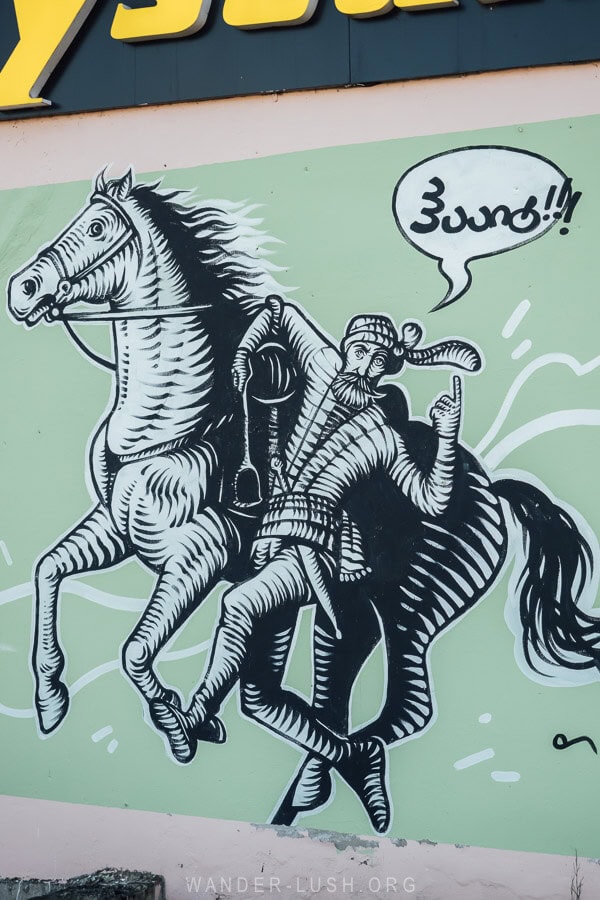
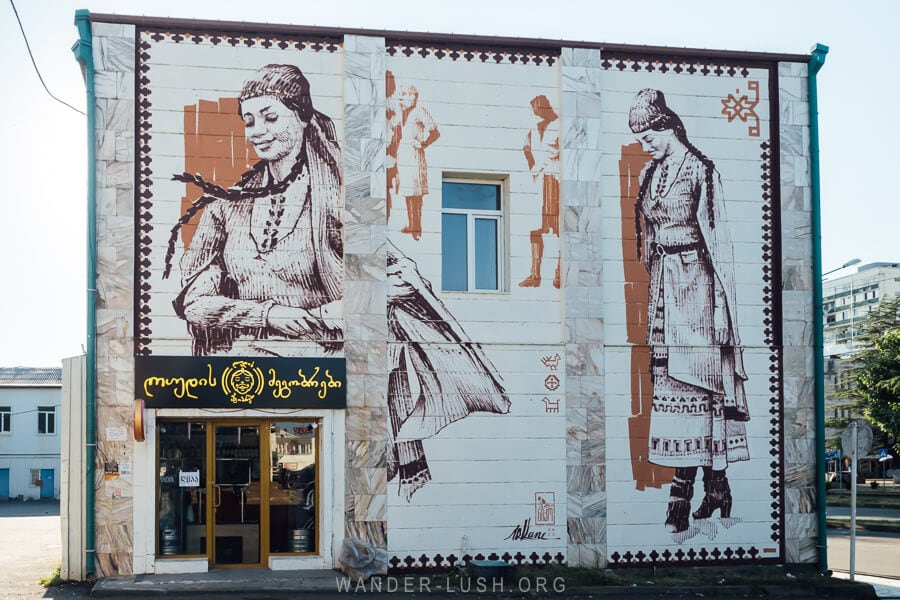
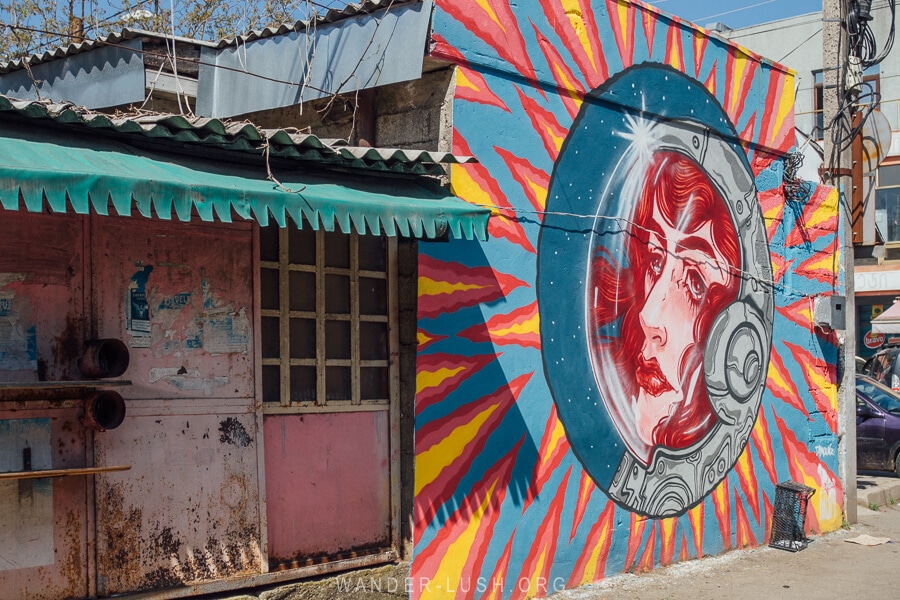
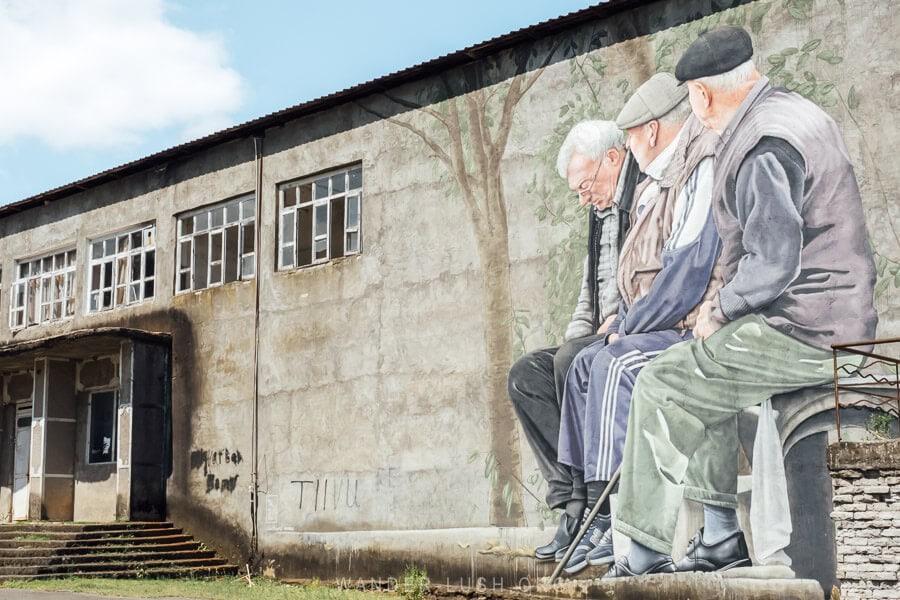
You can find pins for all these murals on my Guria Tourist Map, linked at the top of the post.
8. Track down Ozurgeti’s Soviet mosaics
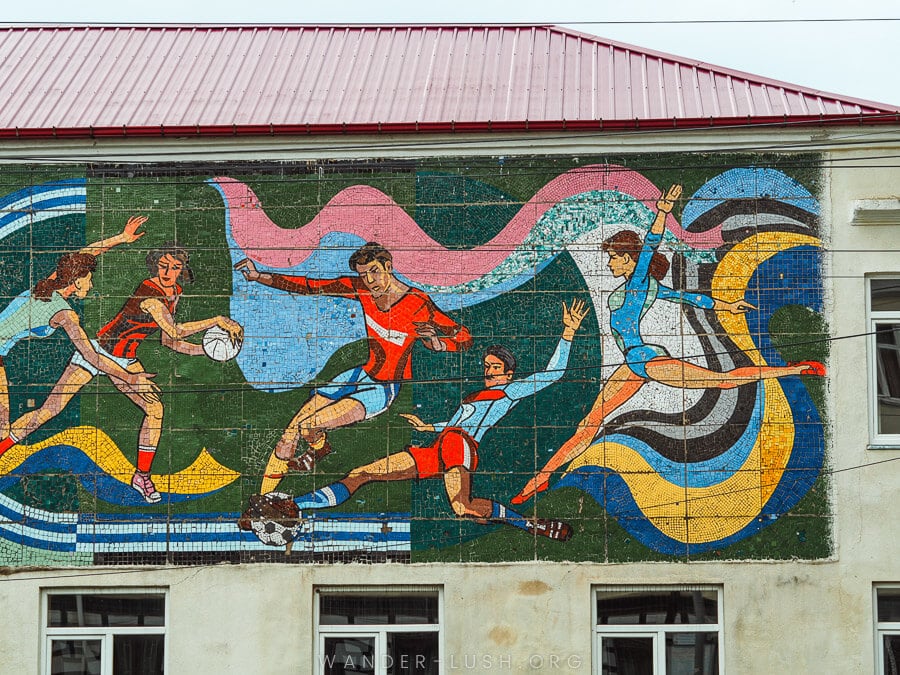
Guria has a very high concentration of Soviet-era mosaics – a testament to the region’s importance during the Soviet period. Most are located outside Ozurgeti and will be covered later, but there are two prominent mosaics in the city that are worth a detour for.
The first adorns the facade of Ozurgeti Public School at 27 Viktor Dolidze Street. Pictured above, it depicts a group of young athletes – volleyball players and footballers – and a gymnast in mid-flight. It’s in very good knick, no doubt because it’s still maintained by staff at the school.
The second mosaic is at the old Askanit clay processing factory near the railway station (pictured below). There are a number of interesting buildings in this area, including a large housing estate that looks almost Bavarian in style. I later learned that the roofless, overgrown brick building with high arched windows next to the train station is an old silk factory.
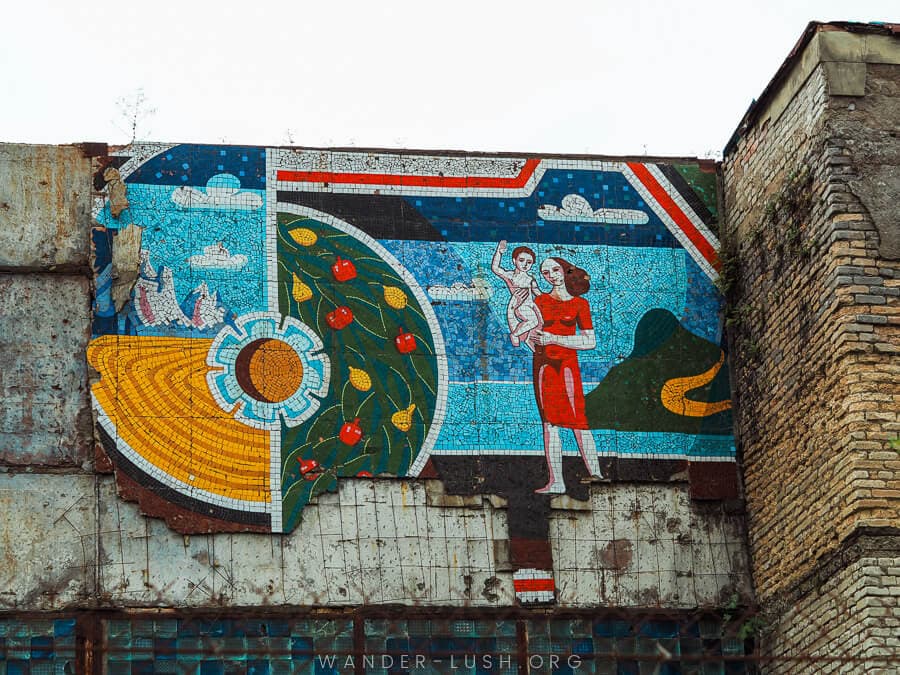
The clay factory is totally abandoned and from what I could see from the fence line, a complete wreck. The partially destroyed mosaic panels line the top of the facade facing the road, so you can get a good look without going inside. The coloured glasswork is also interesting.
9. Eat at Guria’s oldest brewery
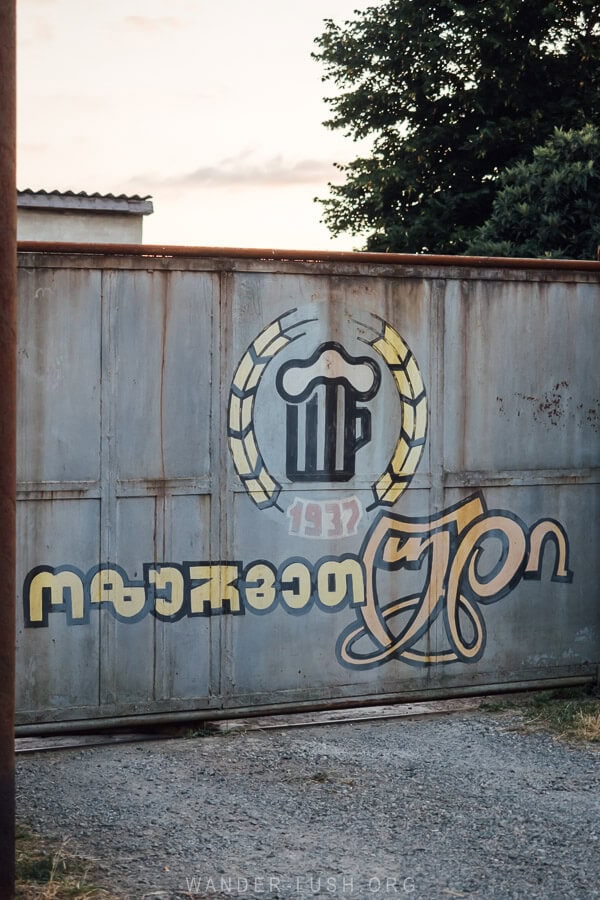
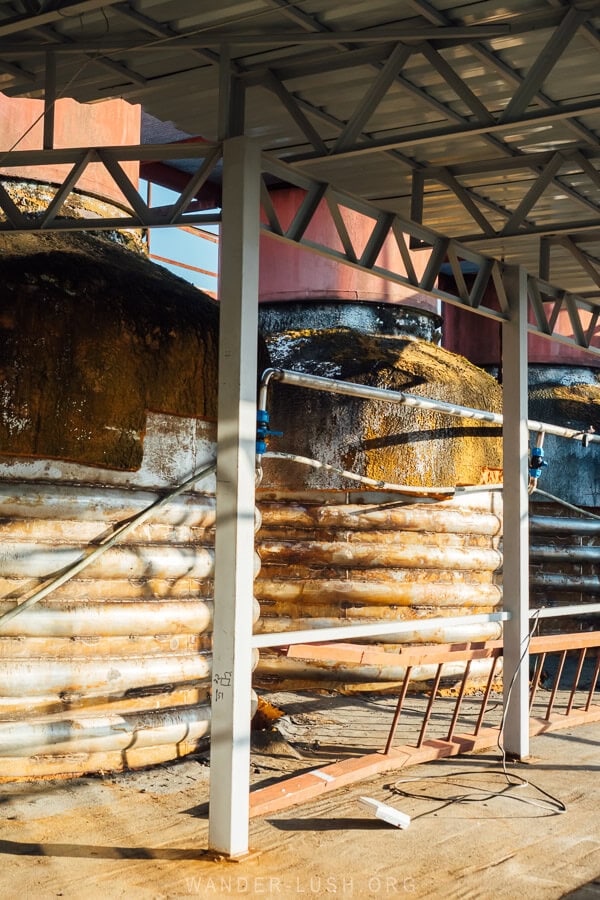
There are not a lot of food options to pick from in Ozurgeti. Two of my favourite places to eat, Eight + 1 cafe and Breaking Breads (home of Georgia’s best club sandwich) have very sadly closed down.
Tonusi is a solid option for lunch or dinner. I only discovered it on my most recent visit to Ozurgeti – I don’t know how I’ve missed it.
Tonusi is located on the grounds of Ozurgeti’s oldest brewery, founded in 1937. Rusted out tuns and tanks line the rooftop and can be seen from the top-floor dining hall. I think they are still in use!
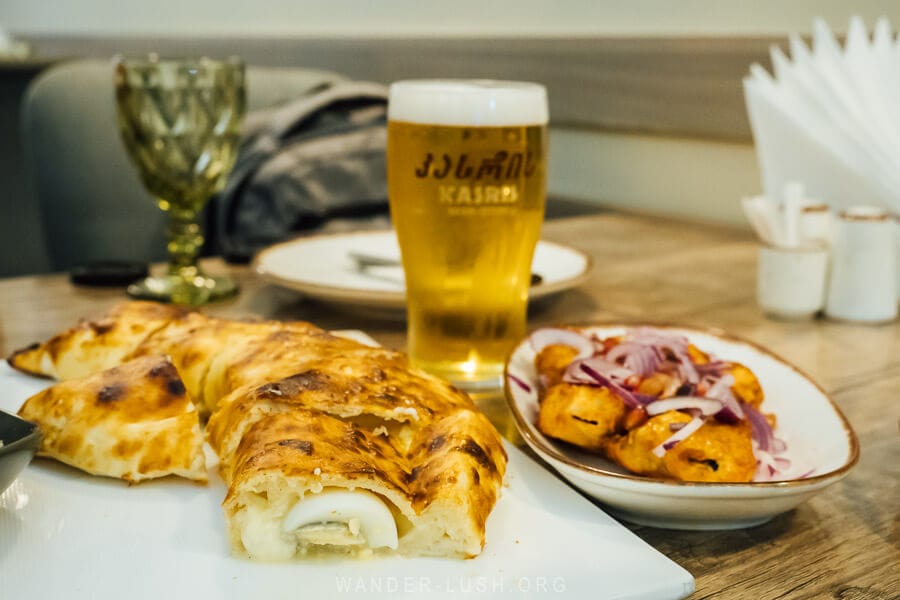
We sat downstairs in the sweet AC and enjoyed a fine dinner of tomato and cucumber salad, chicken mtsvadi BBQ, and Gurian khachapuri. With a draft beer, of course.
There is no English menu, but Google Lens works a charm. Staff are very sweet and eager to help out.
If you have time for more than one meal in Ozurgeti, I can also recommend Pirosmani. It is a typical Georgian banquet hall-type restaurant, with large portions at affordable prices. The ambiance is lacking a bit (the blaring speakers in the enclosed concrete courtyard don’t help), but the khinkali are good.
Pit-stop cafe Coffee In is located in the centre of town and is great for grabbing a coffee and breakfast snack to go. Amazingly, they open at 9am.
Menabde Wine Cellar in Shemokmedi (see below) also offers wonderful homecooked meals, or you could combine lunch with a tea degustation at Teni Tea or Komli (see above).
10. Do a Gurian wine tasting at Menabde
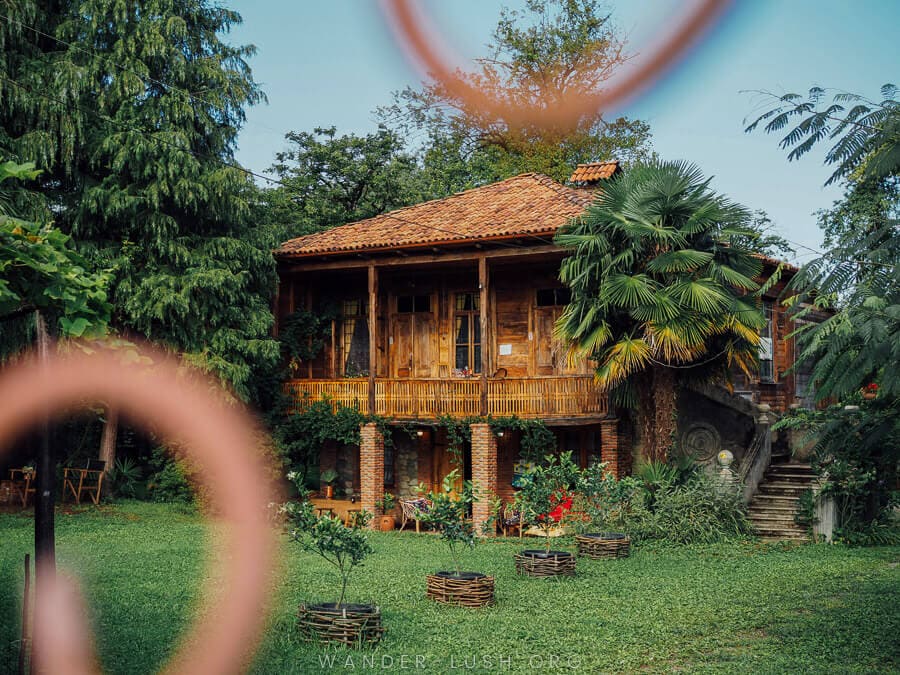
Guria’s vineyards long predate its tea plantations. Because of the hot and humid climate, vintners here use a special technique called olikhnari to grow their grapes on tall props raised above the ground. In the past, some varieties of grapes were even grown on tree trunks. If you visit Teni Tea, ask Gabriel to show you the grape tree!
Chkhaveri is Guria’s most famous grape. It is commonly used to produce a light, fresh qvevri red with notes of summer berries and a subtle spice.
To be completely honest, I didn’t like Chkhaveri the first time I tried it. But as I discovered, it needs more time than average to breathe and mellow out. I.e. it gets better the deeper into the bottle you go!
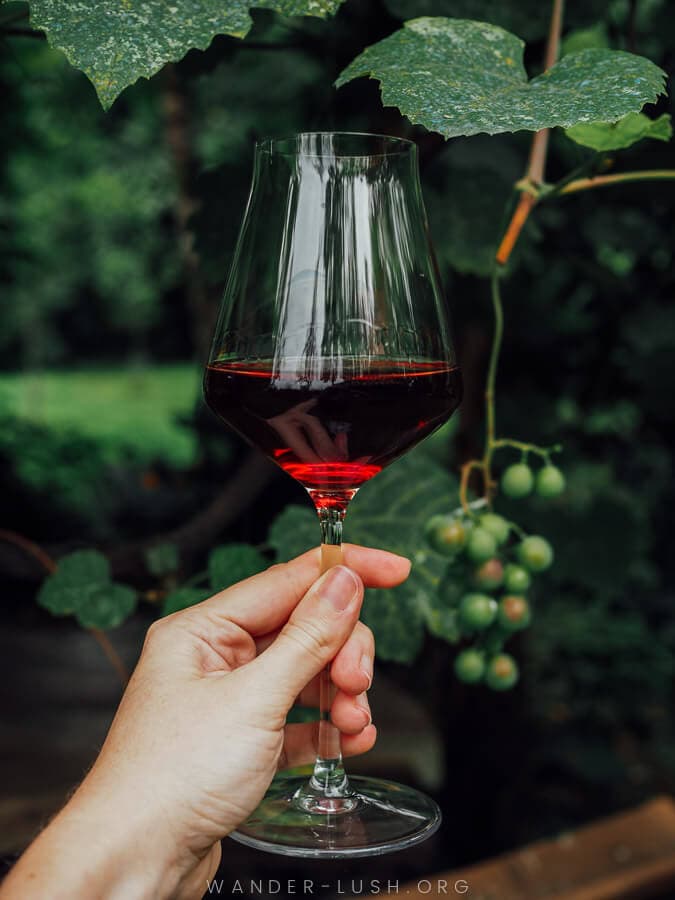
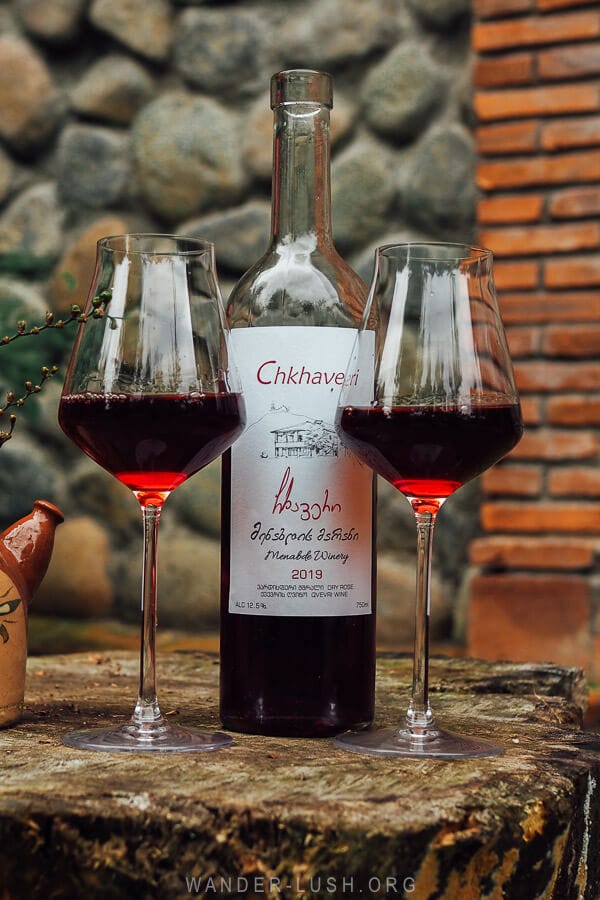
There are a few cellars around Ozurgeti where you can taste Chkhaveri wine. My pick is Menabde, a winery-restaurant-hotel that also offers meals and accommodation. The oda house location in Shemokmedia (not too far from the church) is very sweet.
If you can, do try and eat here – the food is lovely, and the menu features some unusual Gurian specialties you can’t find elsewhere (such as chestnut soup). The buffet breakfast offered to guests is pretty good, too. I have stayed here twice now and I always enjoy it.
This is not a super hands-on venue and there are no tours as such, but walk-ins are welcome to drink wine and order lunch or dinner in the garden. The kitchen is open until 8pm. I recommend calling ahead a day or two in advance to arrange your visit.
Things to do in Guria beyond Ozurgeti
If you have a car and more time to explore, here are my favourite things to do beyond Ozurgeti – including the villages of Upper Guria and the Black Sea Coast.
11. Chase the clouds on Gomismta
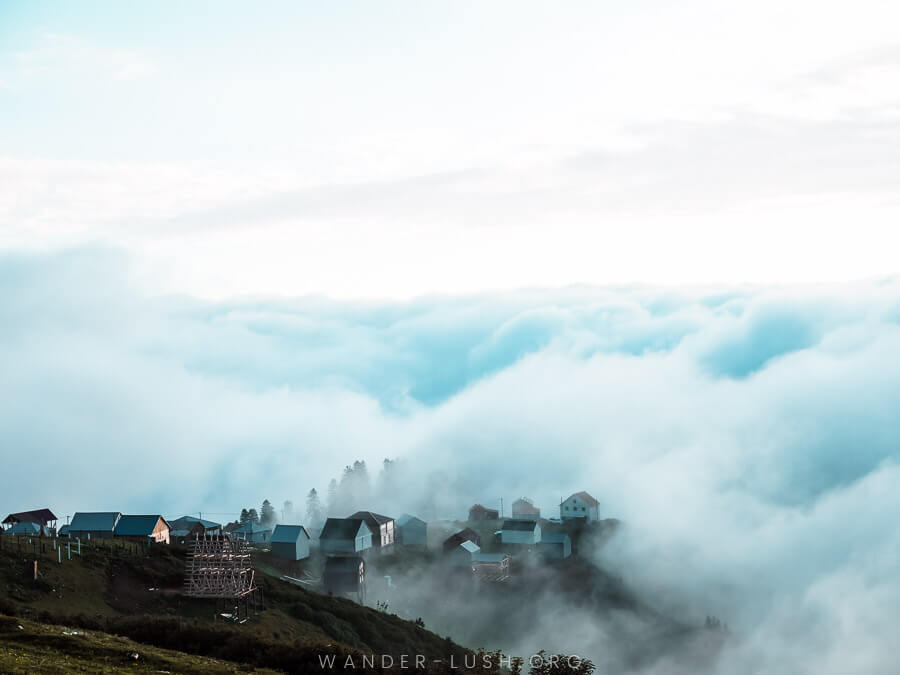
Gomismta is a summer resort located in Guria’s mountainous interior at a height of 2,755 metres above sea level. In the warmer months, shepherds bring their flocks up to pasture here, while local families rent out wooden cabins to wait out the worst of the summer heat in the relatively cool conditions.
The road up to Gomismta is brand new and easy to navigate, even with a sedan. It takes around 45-60 minutes to reach the peak from Ozurgeti. Much of the 35 kilometre-drive is via hairpin bends, but the road is wide and feels safe.
The road is only open in summer, approximately between mid-June and the end of September. There is no public transportation that I am aware of, so you will need to travel by car or taxi. The latter can be organised through your accommodation.
Unusual climatic conditions mean the mountaintops and valleys of Guria are often coated in thick, ethereal mist. At dusk, this creates the illusion of the sun setting over a sea of cotton-balls.
That’s if you’re lucky enough to visit on a clear evening – evidently I was not!
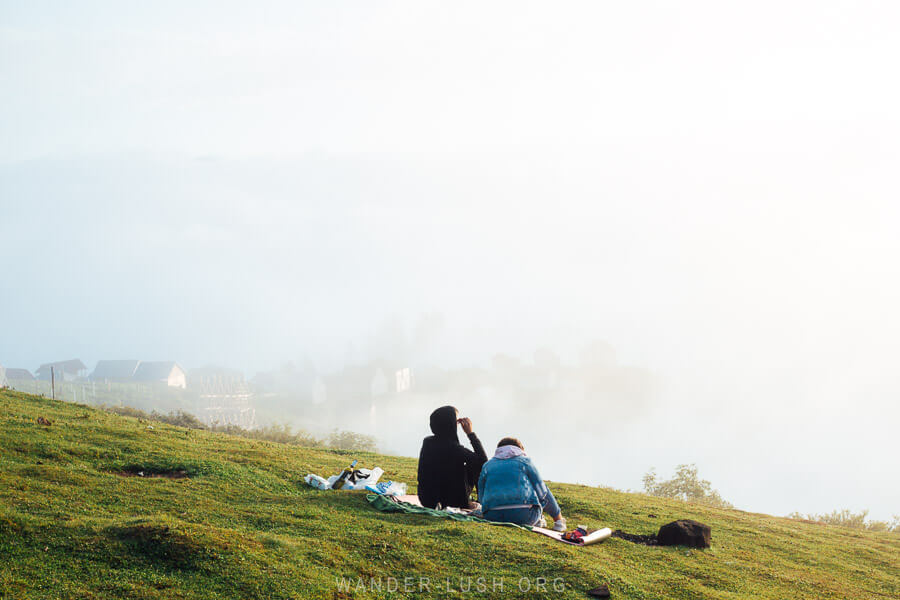
When I lived in Vietnam, my friends called this sort of thing ‘chasing the clouds’. Even if you do encounter a total white-out, it’s still an awe-inspiring experience.
Amenities on the mountain are quite basic, but there are a few cabins and hotels if you want to stay the night. If you plan to drive back to Ozurgeti, take extra care on the steep road after dark.
There is plenty of long-distance hiking available in this underrated area, including an option to hike up to Gomismta from the nearest village. There are trails linking Gomismta with Bakhmaro (see below), and a beautiful multi-day walk from Gomismta to Goderdzi in neighbouring Adjara region that I would love to try some time.
12. Watch the sunset from Bakhmaro
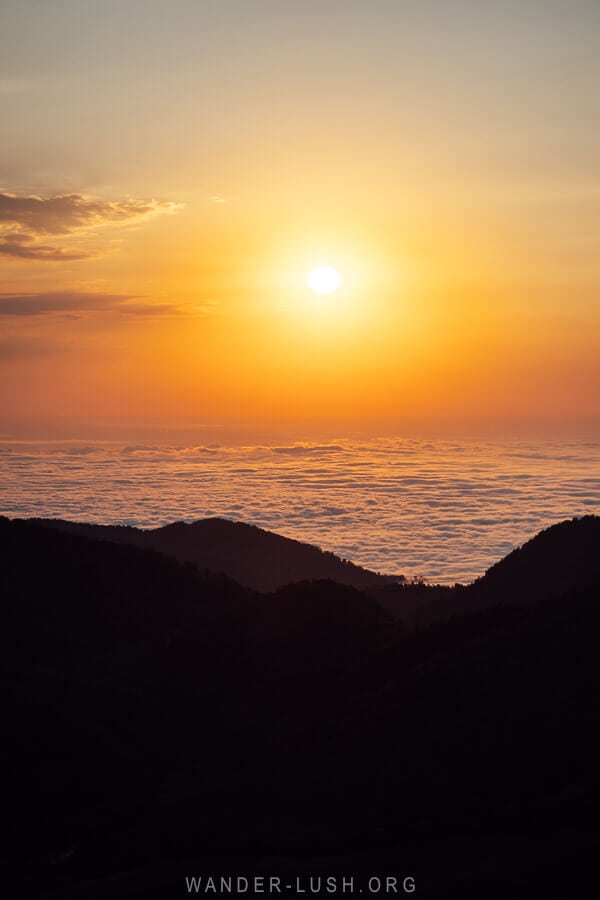
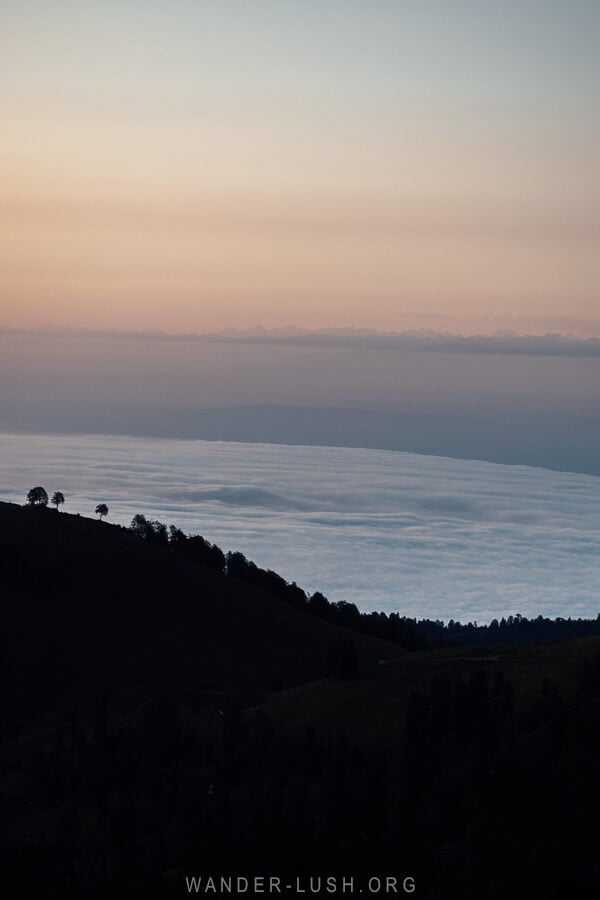
Bakhmaro is a little further from Ozurgeti (around 2 hours’ drive) but has more on offer in terms of things to see and do. I also think the sunset here trumps the one on Gomismta – that is just my personal opinion!
Unlike Gomi, Bakhmaro resort is located in a valley. The main settlement is a whopping 1,950 metres above sea level. It too has quaint A-frame cabins arranged along its sloping hills amidst lush pine forests. Bakhmaro Church, aptly fashioned from wood, is one of the cutest mountain chapels I have ever seen.
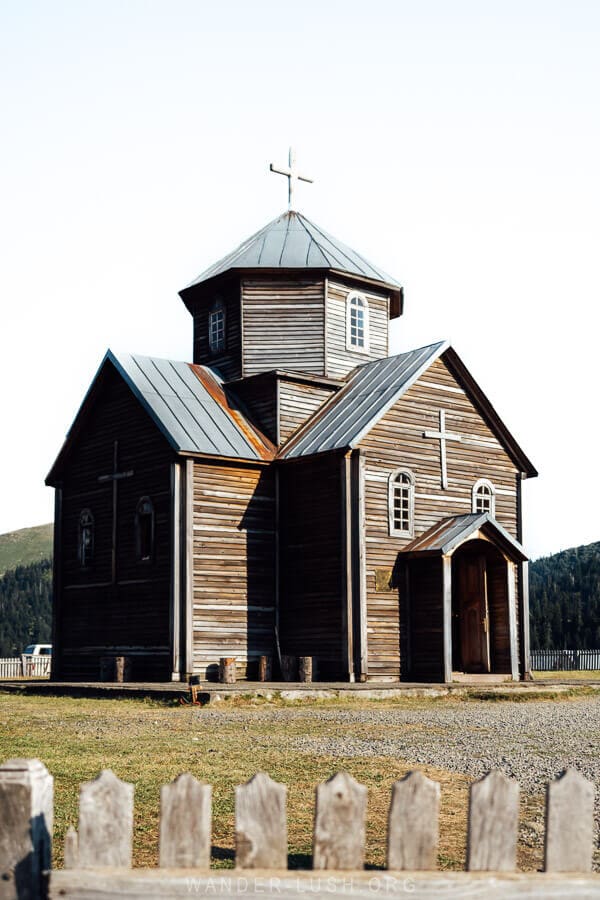
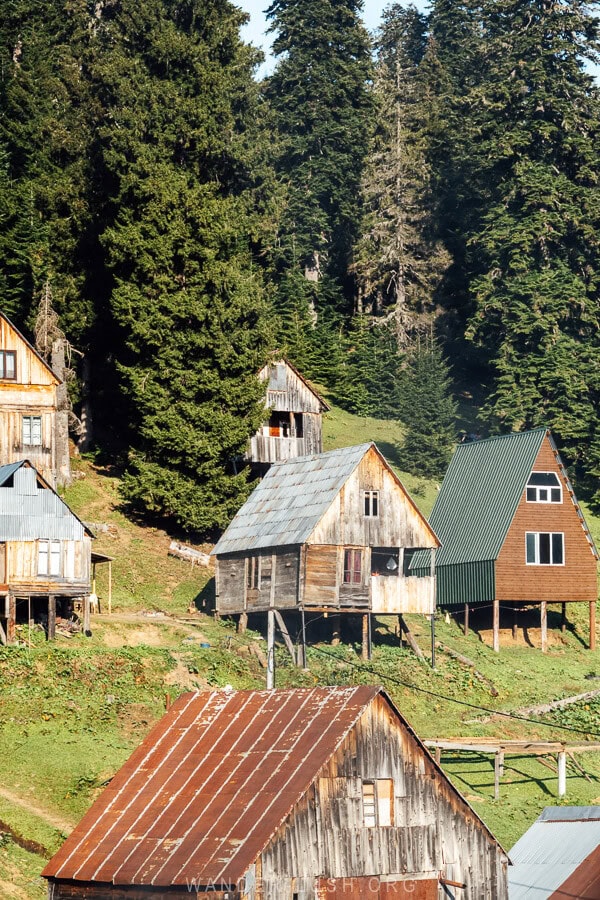
Bakhmaro’s so-called ‘Sunset Mountain’ is located an hour or so by foot from the town via a very steep, uneven path. It is a mildly challenging walk, but I do think the views of the clouds are enough to make it feel worthwhile.
Especially if you’re lucky enough to visit on a clear evening – which this time I was!
Bakhmaro is of course the venue for the annual Horse Cup on August 19. If your timing is right, it is a great day out. The festival ends in the late afternoon, leaving you enough time to hike up to the viewpoint for sunset.
The Bakhmaro Road is closed in winter, too. In the summer months, there is a once-daily marshrutka van from Ozurgeti.
For more things to do in Bakhmaro, photos of the horse race and detailed transportation tips, see my Bakhmaro Travel Guide.
13. Track down Soviet-era architecture, culture houses & village halls
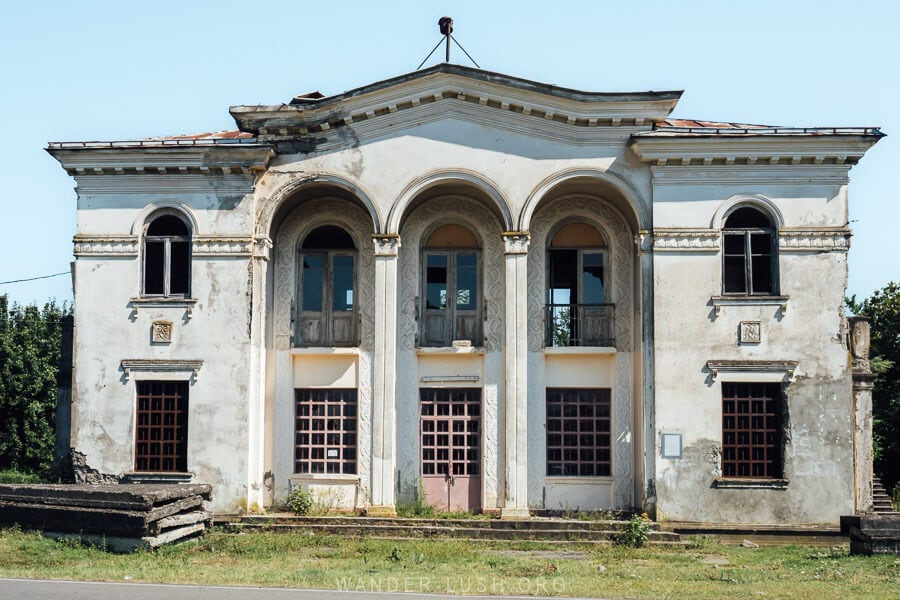
Guria is brimming with unbelievably ornate architecture from the Soviet period. Villages such as Shroma and Natenebi knew incredible wealth in the 50s and 60s (thanks to the tea, citrus and corn farms), and had populations big enough to justify building theatres, village halls and schools.
Many of these buildings now lay partially or fully abandoned. This includes two Collective Farming (kolkhoz) Administration Buildings in Shroma (dated 1956) and Natanebi (dated 1953).
Natanebi’s is located on the main road in the former village of Shava, while in Shroma, you will need to follow the long and winding road to the top until you see the humongous building looming in a clearing to your left.
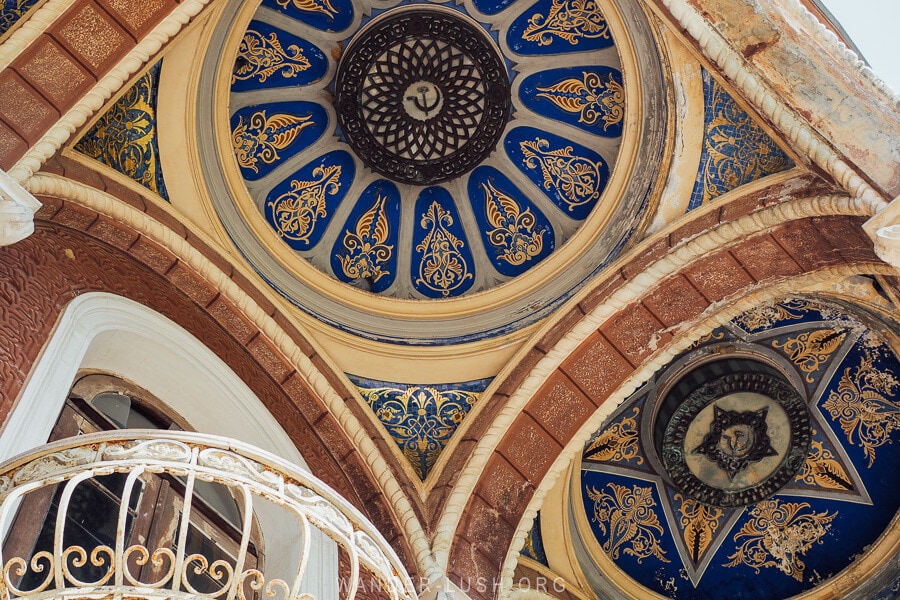
Pictured above, the hall in Natanebi is faced with an impressive portico, still with communist insignia on its ultramarine domes.
Usually when you visit places like this, you find them abandoned and forgotten. So I was rather surprised when a man named Zaza pulled up and offered to give us a tour of the building, which now serves as his gym.
On the ground floor, there is a WWII memorial. Upstairs, pads have been laid out over the parquetry, small pairs of wrestling boots strewn everywhere. The original wrought iron bannisters and wall lamps have been kept in mint condition.
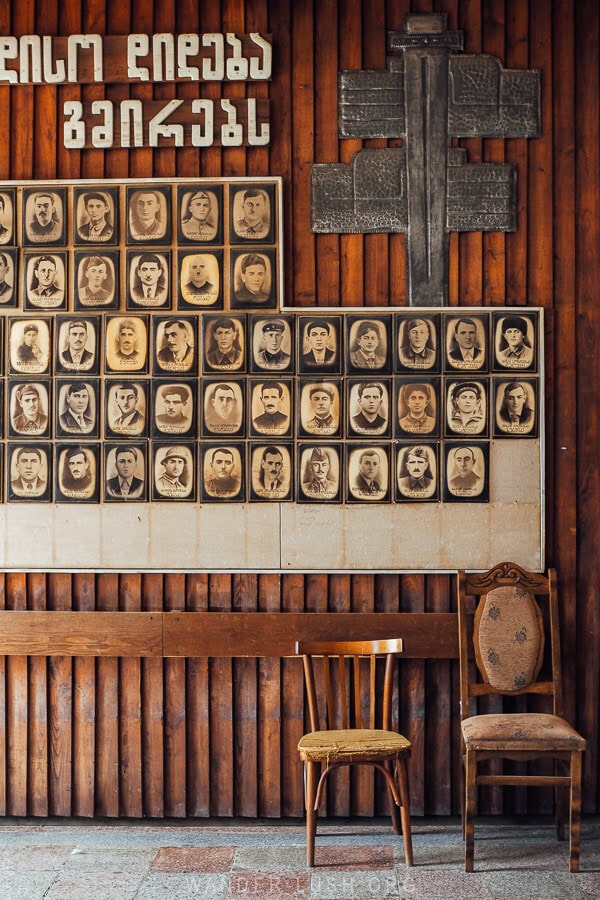
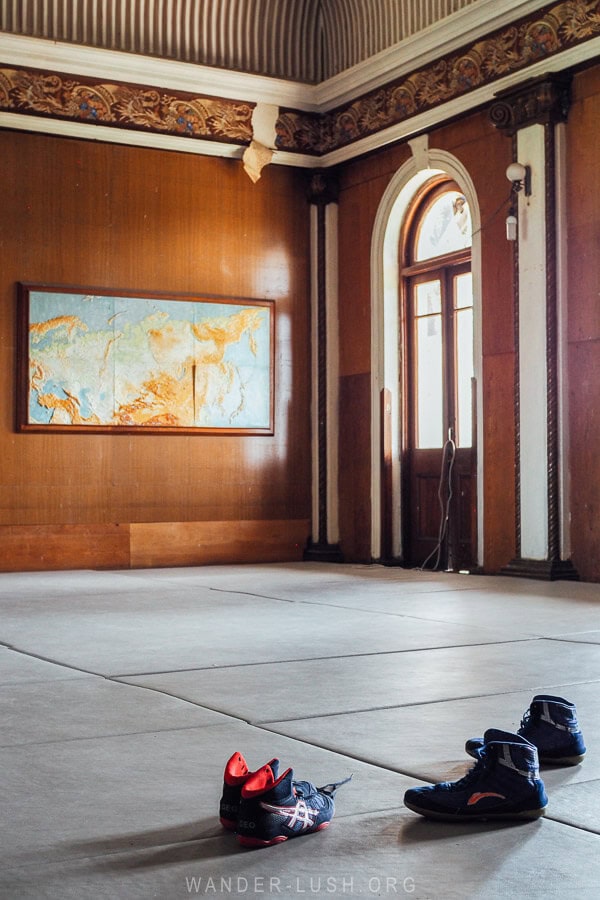
The hall in Shroma (pictured below) is better-known to photographers because the doors are always open.
Its grand entryway features elaborate plasterwork, friezes, ceiling roses and glass mosaics. Portraits of village leaders (I assume?) still hang on the walls. I had a peek through a few doorways and most of the offices are completely ruined, floorboards stripped and filled to the brim with junk.
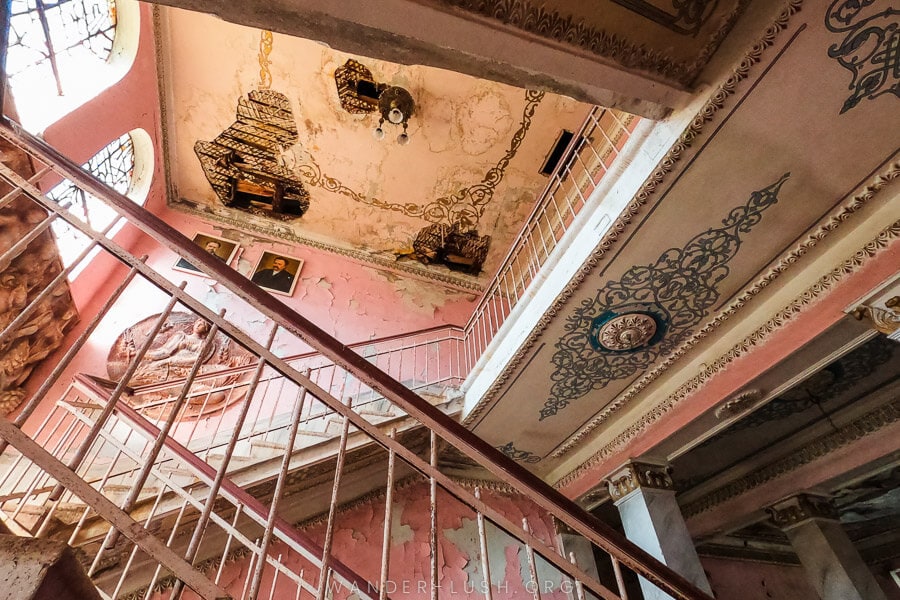
Outside, there is a huge and very beautiful Soviet-style mosaic that commemorates WWII and Georgia’s brotherly relationship with Ukraine.
After the war, it’s said that residents of Shroma purchased a tank to endow the memorial – indeed, you can see the tank nearby.
Shroma’s Village Culture House is also very impressive but more difficult to access.
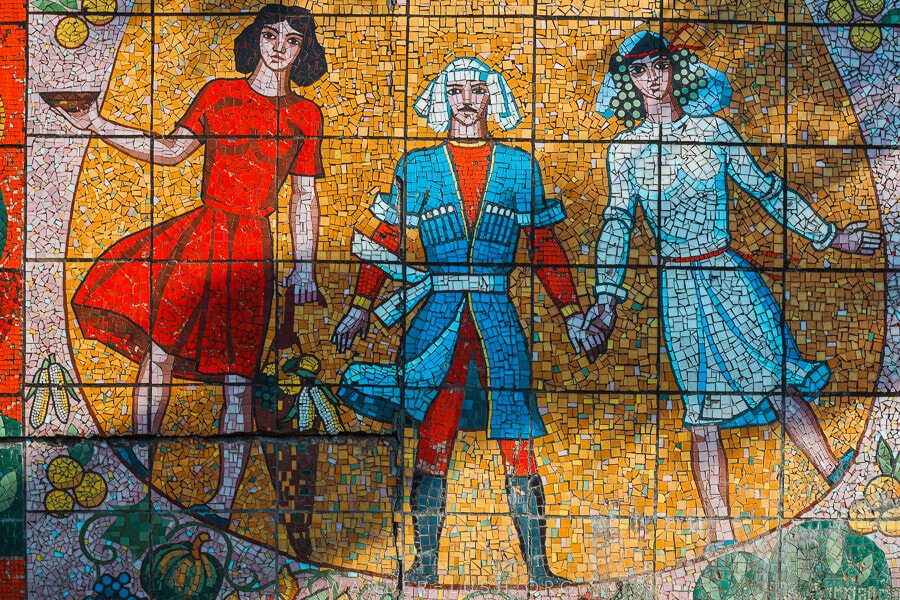
Off the main road in Nagomari there is a complex of three brick-coloured buildings with tall columns. One is labelled Nagomari Tea Cooperative and was clearly used as a theatre.
It is completely gutted (last time I was there, it was being used as a horse stable), while the nearby school and kindergarten have also been abandoned.
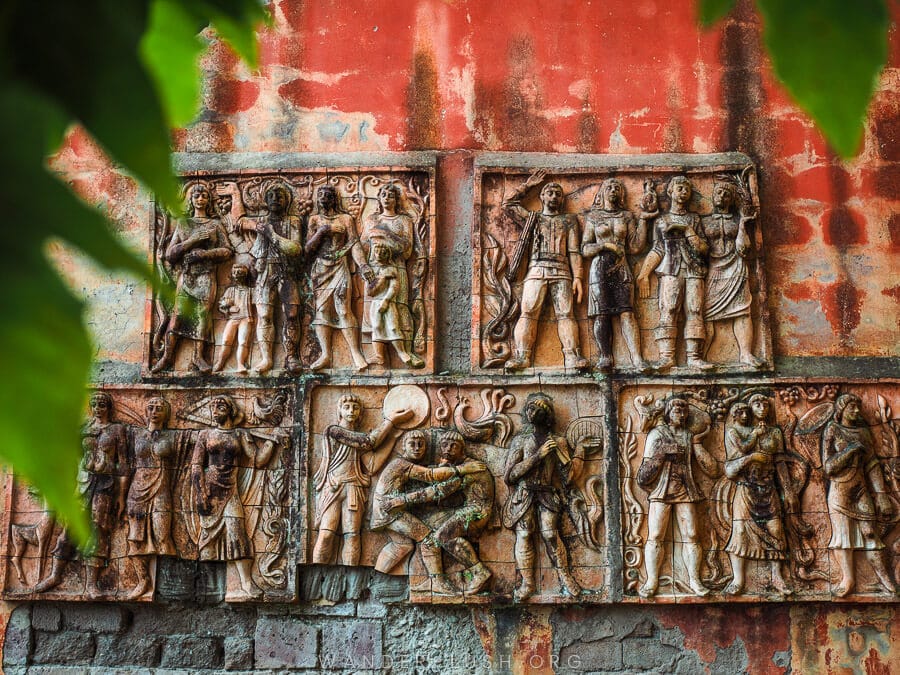
There are countless more relics of the Soviet period dotted around Guria – every time I drive around this region, I spot something new to explore.
14. Search for Soviet bus stops & mosaics
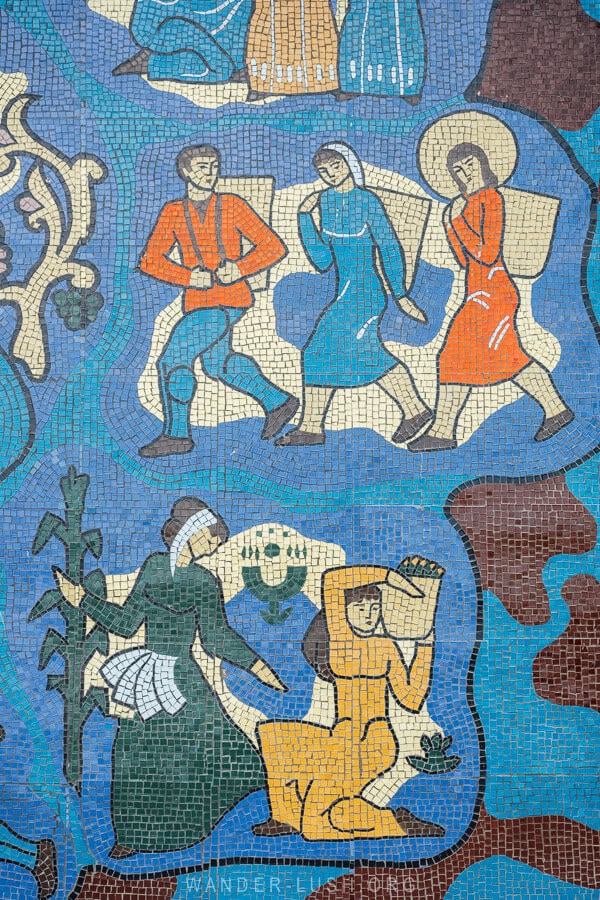
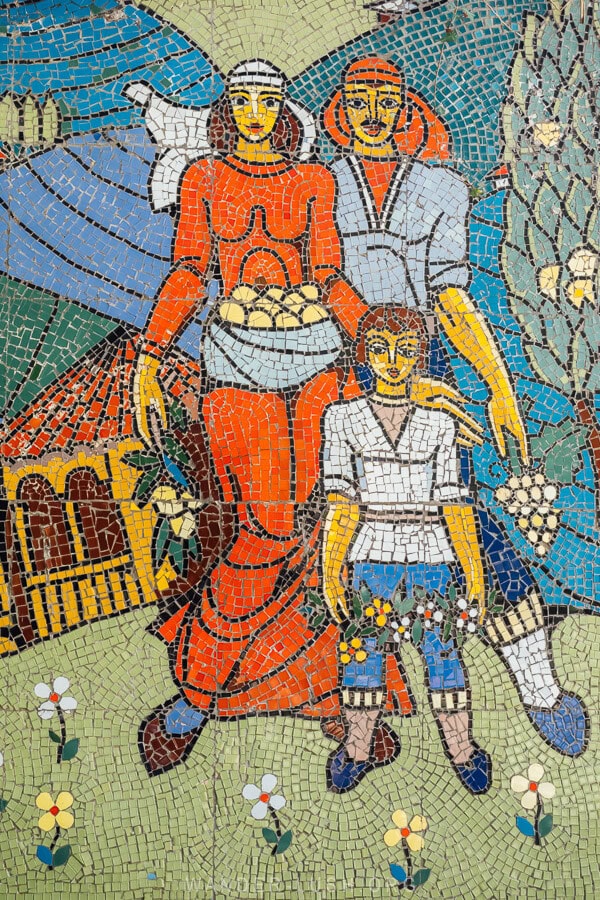
You will also see a huge number of Soviet-era bus stops in Guria. Many are decorated with mosaics that reflect the main industries of the day (tea, citrus, corn) mixed with motifs of traditional dancers, musicians, folklore and legends.
One of the biggest perks of having your own car is being able to stop off at the many ‘surprise’ monuments that pop up along the roadside.
Particular bus stops to seek out include the one in Gurianta, pictured below. The peaked wooden shelter (clearly restored and probably originally made of concrete) is totally unique. Its mosaic pannos depicting tea pickers and hazelnut farmers are just as vibrant as the day they were laid.
The name of the artist and year of creation are unfortunately unknown.
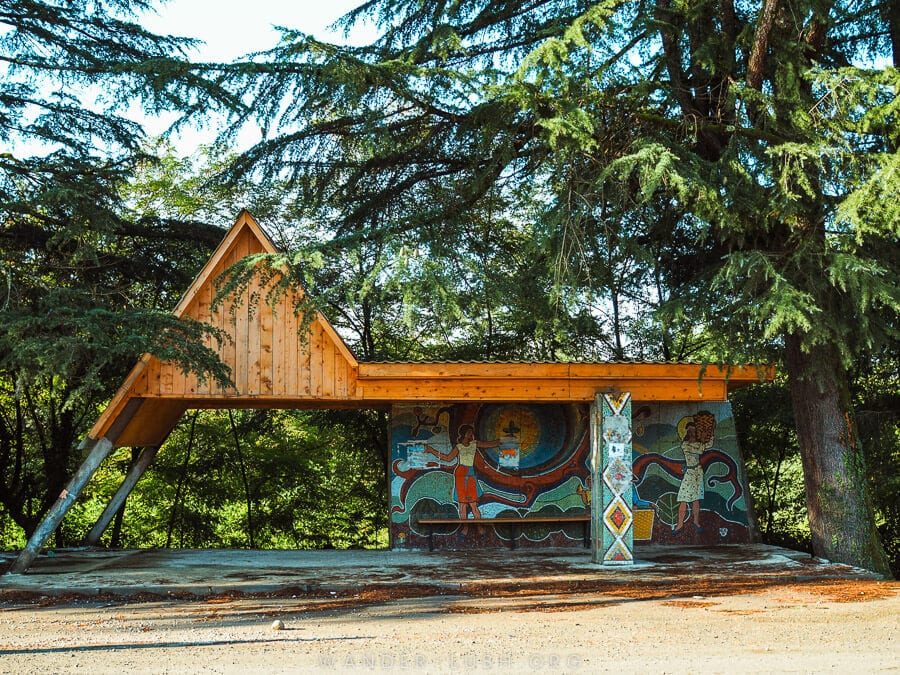
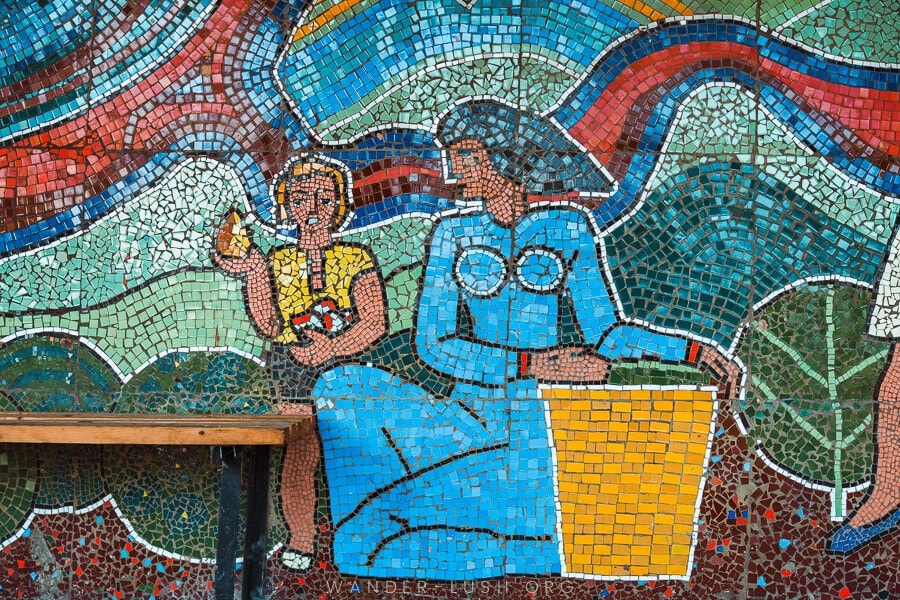
Also worth a special trip to see is the kindergarten mosaic in the village of Naruja outside Anaseuli. It covers the entire side of the building and is in impeccable shape – clearly the staff of the still-running kindergarten have invested a lot of time and work into the preservation.
This one has a symmetrical design, with a young girl dressed in a canary yellow frock beneath a smiling sun at the centre. Different characters that reflect children’s stories and myths surround her. I could pick a few of them – as I learned when visiting the former Pioneer Camp outside Sabaduri Forest near Tbilisi with a Georgian friend, many of the fairytales told to kids in the USSR were adapted from Western fables.
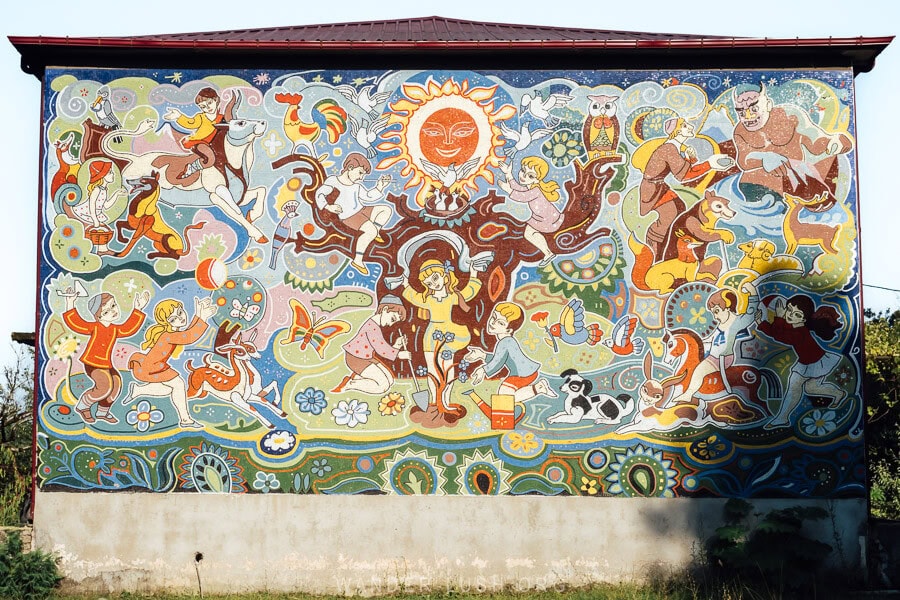
In the garden you will see a series of bas-relief sculptures that decorate a brick wall.
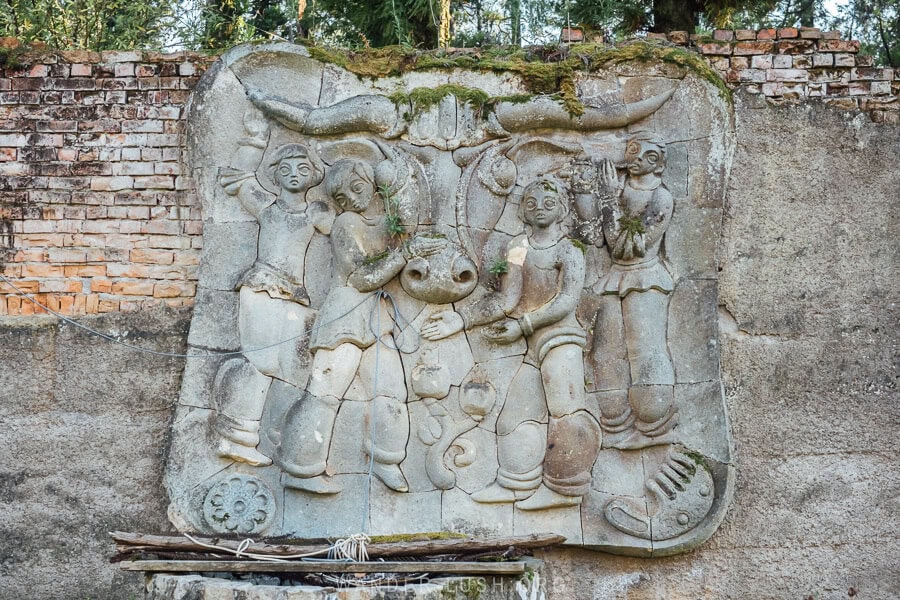
Two of the most unique mosaics in Guria are located in the village of Chaisubani on the Bakhmaro Road. The first depicts agricultural workers, folk music, dance and the game of burti. It has an unusual and very vivid royal blue background.
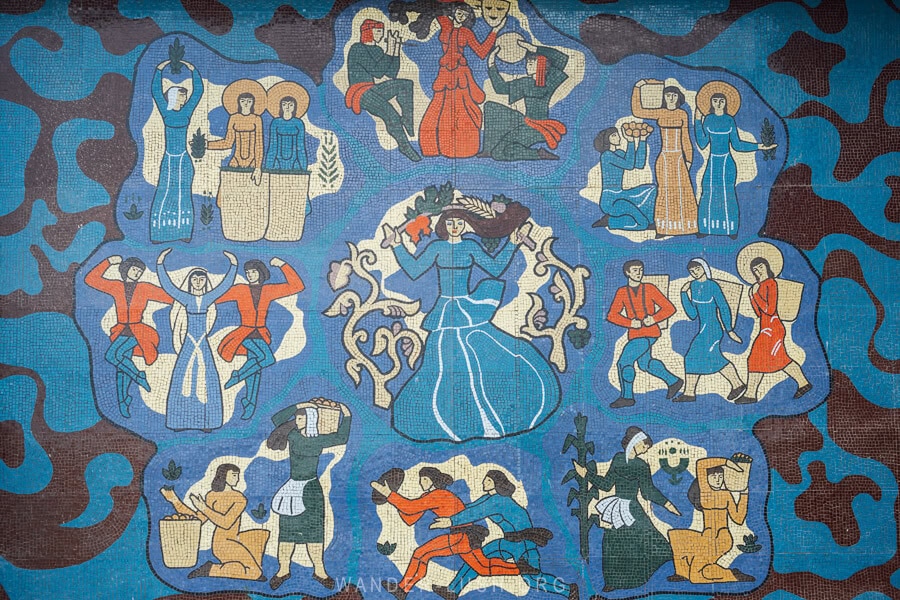
Directly opposite, the Chaisubani WWII memorial has been adapted into a church – so you have the unconventional and rarely seen combination of church and mosaics.
The gate, a large water fountain and the back wall are all decorated with three-dimensional pannos.
15. Attend the Sunday Farmers’ Market in Chokhatauri
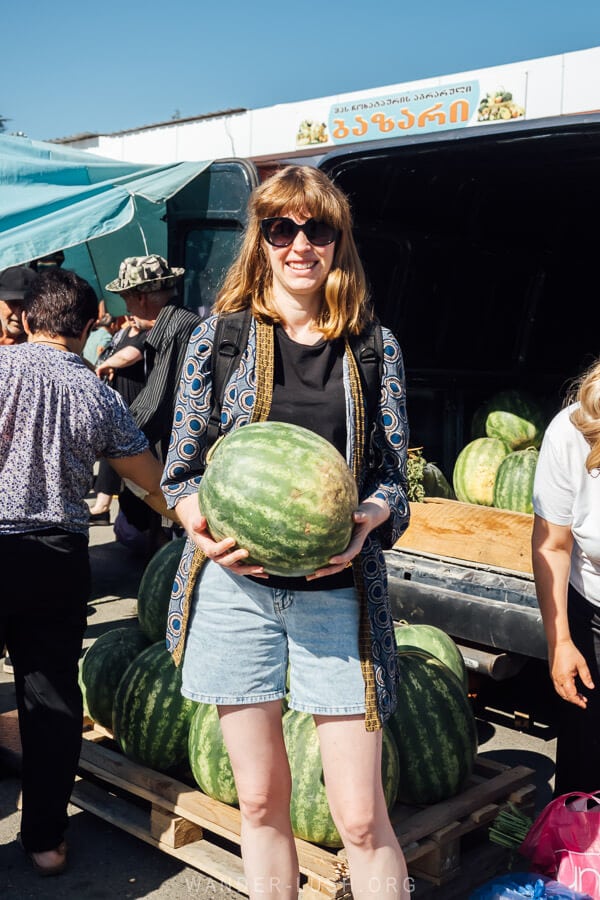
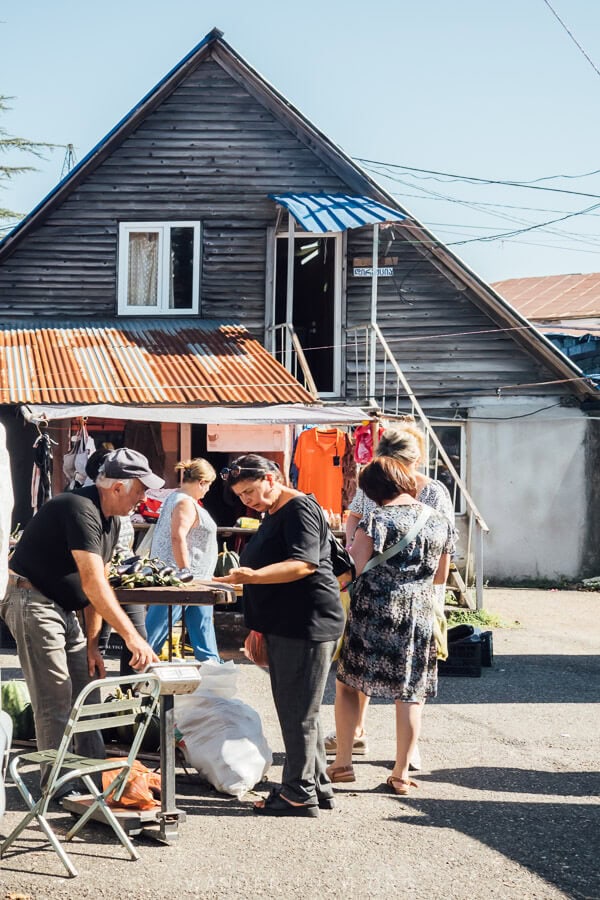
The Chokhatauri Sunday Bazaar is the biggest agricultural market in Guria and an absolute institution. I was very lucky to receive a tip from one of my readers – a local Gurian – about this place.
If you are travelling in or out of Guria on a Sunday morning, it is absolutely worth stopping for. The market has a very different feel from permanent bazaris in Georgian cities – it felt a lot more like an Asian market in Vietnam or Cambodia.
As well as fresh produce, cheese and spices, you will see livestock being sold here along with locally grown tea and tobacco.
One of the pavilions inside the market area is decorated with a lovely set of bas-relief sculptures.
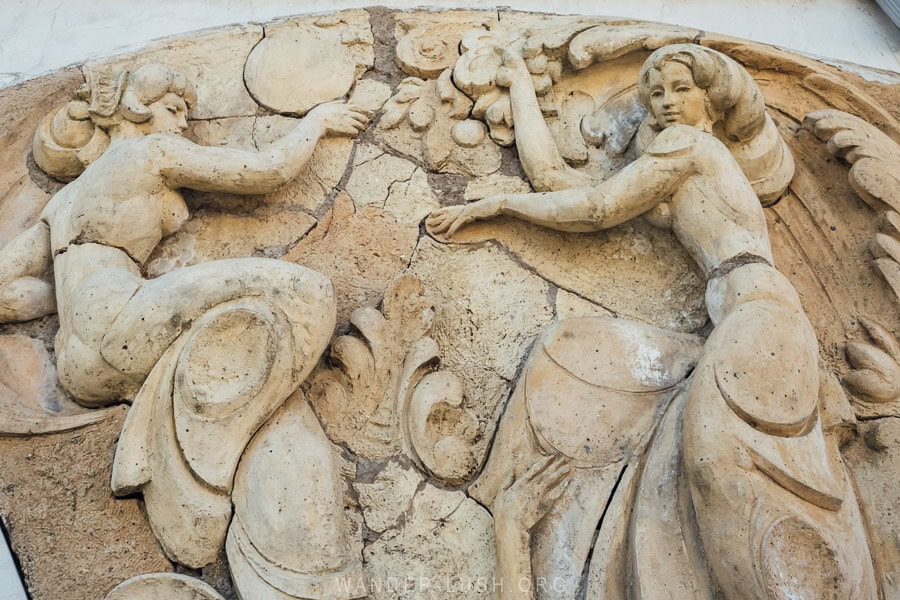
There are more than 60 villages in Chokhatauri Municipality, and I think most people descend on the town for the market.
People greeted us with an outward friendliness that is becoming more and more rare – someone even gifted me a watermelon!
16. Drink Nabeghlavi mineral water from the spring
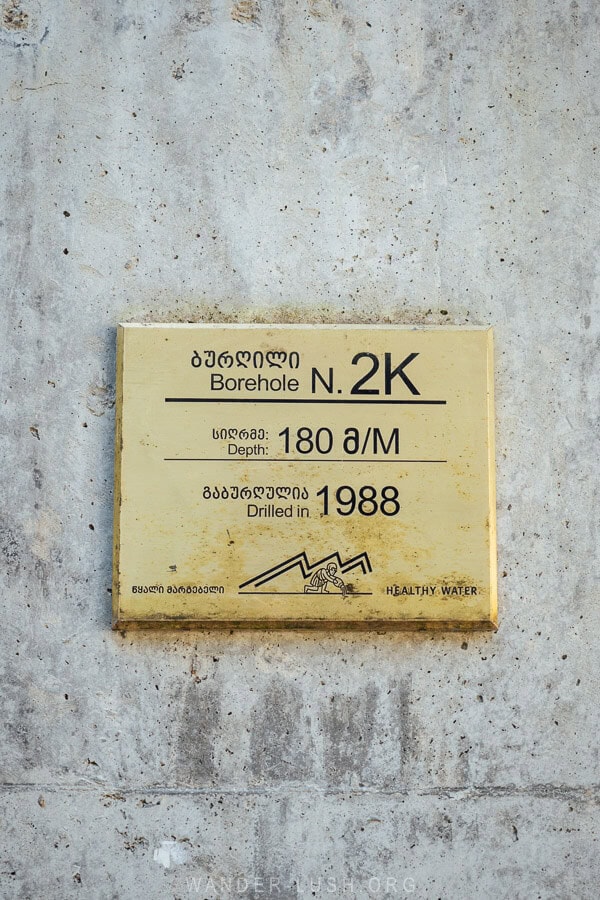
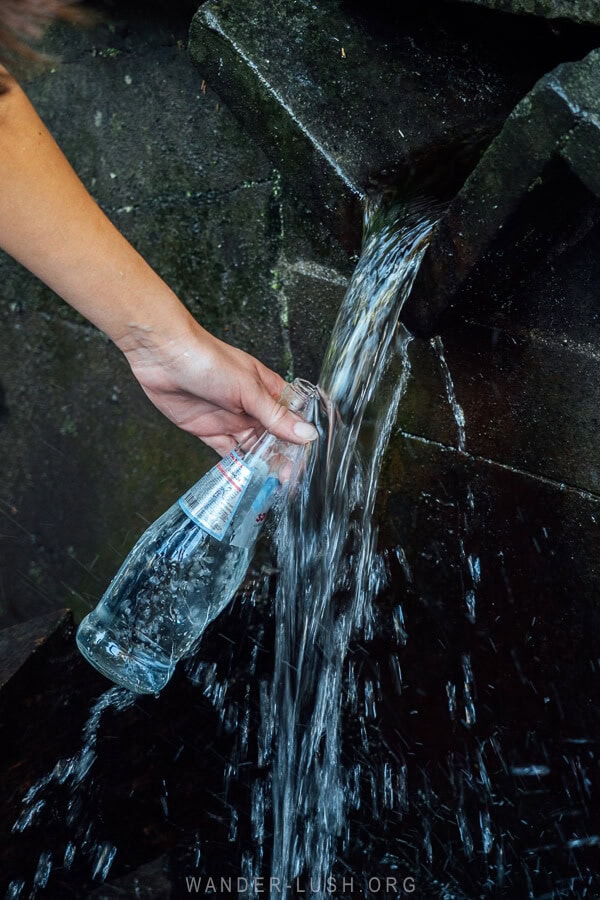
Another stop on the road from Chokhatauri to Bakhmaro, this public spring spurts out a never-ending stream of Nabeghlavi mineral water. Guria’s fizzy water is far superior to Borjomi in my opinion!
Known as Borehole 2K, this spring was drilled in 1988 at a depth of 180 metres. It is actually located on the grounds of the Nabeghlavi bottling factory – to get there, take the turnoff right after the factory and cross the bridge. You will see a concrete box with two taps where you can fill up as many bottles as you like.
The taste is nothing like the bottled Nabeghlavi you get in the supermarket. It is only slightly effervescent, a bit metallic – but still refreshing. It will stay good for a couple of days as long as you keep it out of the direct sunlight.
17. Eat fresh trout at Restaurant Achi
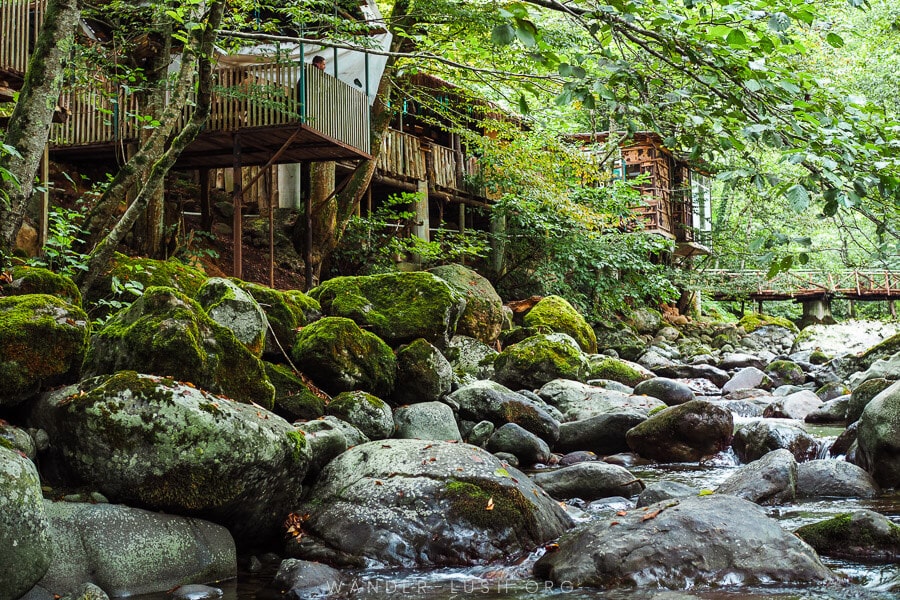
I have our first hosts in Ozurgeti, Misha and Chika, to thank for this recommendation. Achi is a tiny village 15 kilometres south of Ozurgeti on the edge of a pretty river. Restaurant Achi – which I’m told is a bit of a local institution – specialises in river trout, caught fresh and cooked to order.
This isn’t any old trout, though – it’s stuffed with bazhe spiced walnut sauce (more like a paste in this instance) and topped with lemon. Delicious.
The little wooden bungalows perched over the river are the perfect backdrop to a hearty lunch. Just don’t forget your bug spray.
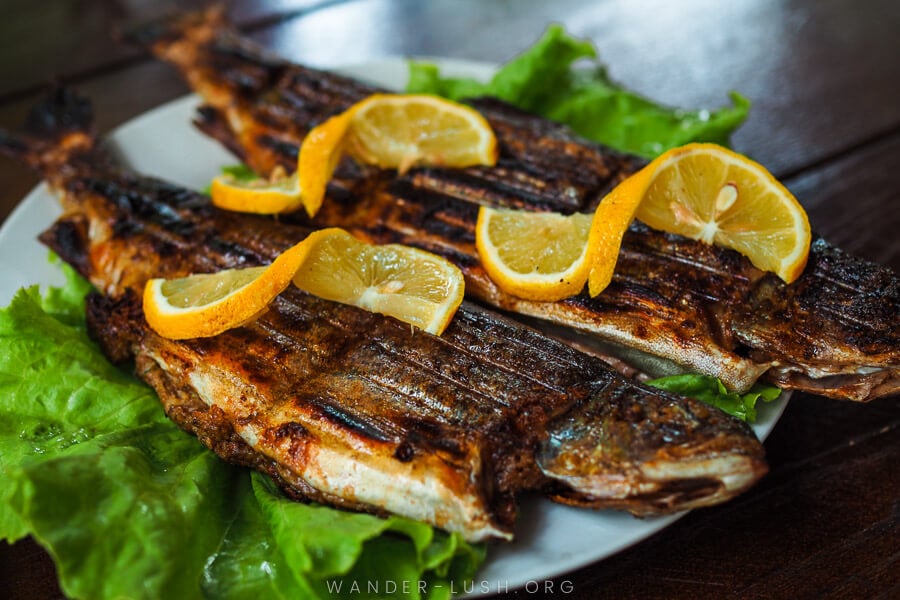
If you’re driving to Restaurant Achi from Ozurgeti, take the road through Likhauri and follow the road signs towards Achi from there. The drive takes around 20 minutes.
Along the way, stop at the lovely Achi Church to see the unusual frescoes of Pontius Pilate.
18. Swim on a black sand beach in Ureki or Shekvetili
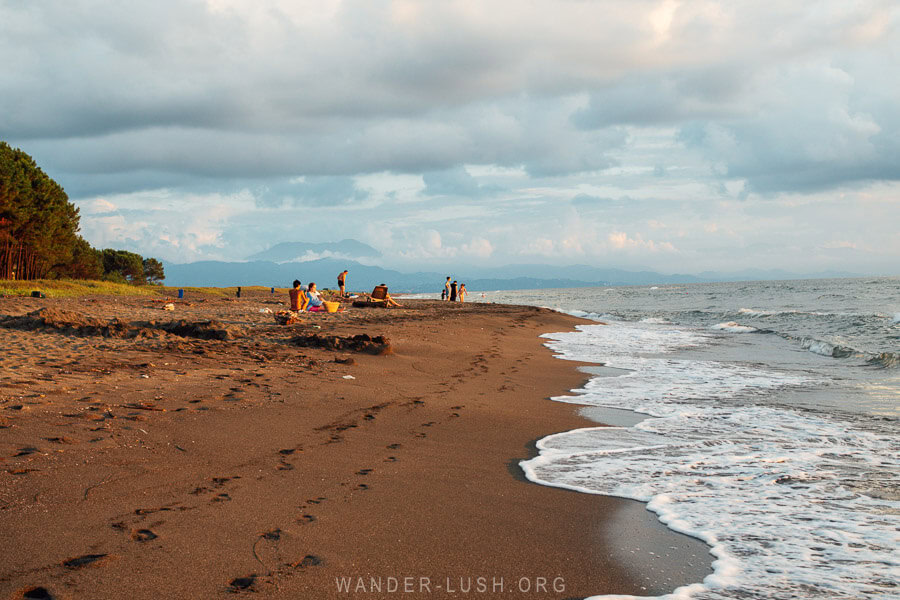
Guria’s 22-kilometre stretch of Black Sea coastline is home to several popular beaches, including Ureki, Shekvetili and Grigoleti. All feature ‘magnetic sands’: dark-coloured, finer sands that are high in iron and other minerals and thus lauded for their curative properties.
This stretch of coast is much quieter and much cleaner than the resort city of Batumi and most beaches in Adjara, including Kobuleti. The furtherest Gurian beach north, Maltakva is nice too – I visited it a few years ago from the opposite direction when in the port city of Poti.
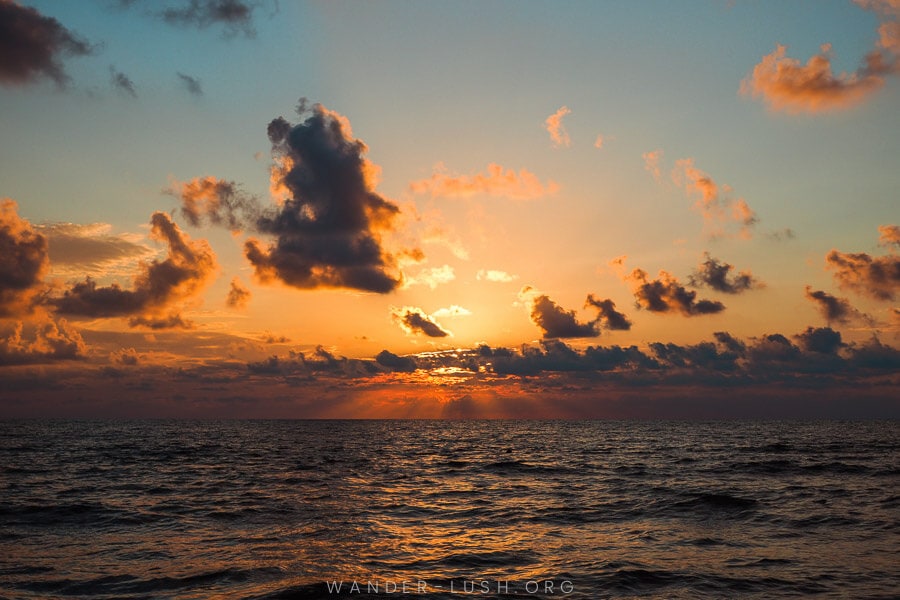
I personally prefer Shekvetili over Ureki. It is quieter, but it still has with a good range of accommodations and a few food options (including the wonderful At Nellie’s restaurant).
It is extremely seasonal so you won’t find anything open outside the summer months.
Sunsets on the Black Sea coast are something else, and Shekvetili is no exception. The beach is just a 40-minute drive from Ozurgeti, but I highly recommend spending a night here so that you can enjoy the sunset and dinner.
19. Visit the Miniature Park & Dendrological Garden in Shekvetili
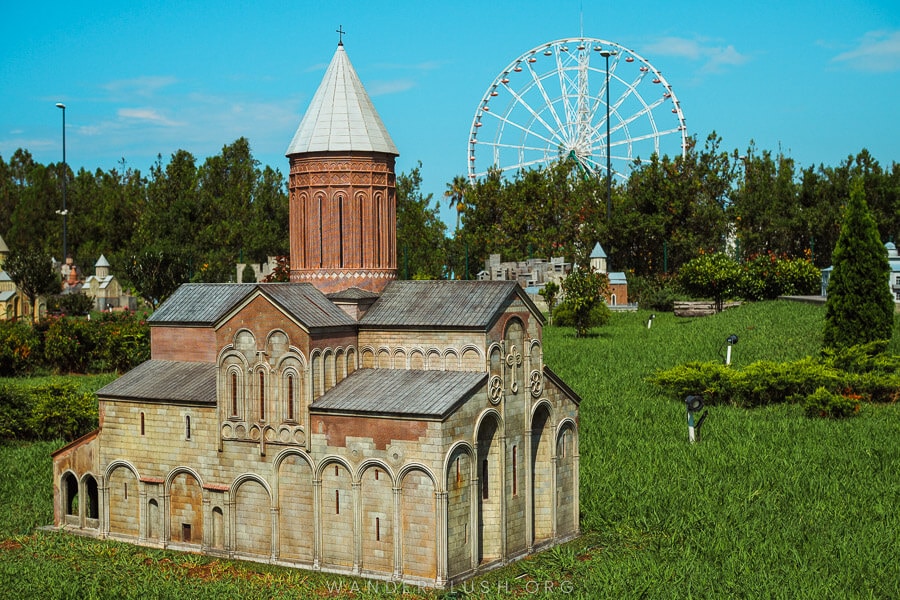
Shekvetili Miniature Park was our wildcard for Guria and despite my suspicion that it would be underwhelming, I’m so glad we made time for it.
Attached to the huge and rather gaudy Tsitsinatela Theme Park, the Miniature Park is located a few minutes south of Shekvetili Beach. Technically it is just over the border in Adjara Region, but never mind!
This is essentially an open-air museum dedicated to Georgia’s most famous landmarks, all immortalised in miniature form and clustered together around a set of walking paths. Mini Svetitskhoveli sits next to a tiny set of Tush towers, a tiny version of Oni Synagogue and a scaled-down version of Narikala Fortress.
If you’ve been travelling around Georgia for a while, it’s really fun to spot the buildings you’ve seen in person and pick out the ones you’ve missed. Everything is well-signed and you can learn a lot from the information panels.
The Miniature Park stays open until midnight in summer. I recommend you avoid visiting during the middle part of the day as it’s completely exposed and very hot. Entrance costs 14 GEL.
Just up the road, Shekvetili Dendrological Park covers 60 hectares along the coast and is home to more than 200 old-growth trees and 58 species of birds, including flamingos.
Having launched in 2020, the park is the pet project of a very controversial figure in Georgian politics. There’s even a documentary about it, Taming the Garden, which reveals how the billionaire owner transported the trees to Shekvetili by barge across the Black Sea.
Shekvetili Dendrological Park is open on Tuesdays, Wednesdays, Fridays, and weekends. Entrance is free.
Have you explored this part of Western Georgia? Do you have any recommendations for me for next time?
If you’re planning a trip to Georgia and you have any questions about Guria or anything else, feel free to leave me a comment below and I’ll do my best to help out.
You might also be interested in…
Georgia essentials
Here are the websites and services I personally use and recommend for Georgia. Check out my full list of travel resources for more tips.
FLIGHTS: Search for affordable flights to Tbilisi, Batumi or Kutaisi on Skyscanner.
TRAVEL INSURANCE: Insure your trip with HeyMondo, my preferred provider for single-trip and annual travel insurance (get 5% off when you book with my link).
SIM CARD: Magti is my preferred provider, with prices starting from 9 GEL/week for unlimited data. See this guide for all the details about buying a Georgian SIM card.
AIRPORT TRANSFERS: Most flights into Georgia arrive in the early hours. For ease, pre-book a private transfer from Tbilisi Airport to your hotel (from $17) or from Kutaisi Airport to Tbilisi (from $90) with my partners at GoTrip.ge.
ACCOMMODATION: Booking.com is the most widely used platform in Georgia. Use it to find family guesthouses, private apartments, hostels and hotels around the country.
CAR HIRE: Find a great deal on a rental car in Georgia – use the Local Rent website to book through a local agent (prices start from $20/day).
DAY TRIPS & CITY TOURS: Use Viator or Get Your Guide to browse a range of day trips and city tours. For off-beat programs, I recommend Friendly.ge (use the promocode wanderlush for 10% off). For in-depth day trips to Georgia’s wine regions, I recommend Eat This! Tours (use the promo code wanderlush for 5% off).
PRIVATE TRANSFERS: GoTrip.ge is a terrific service for booking a private professional driver and car for the day. Use it for A-to-B transfers, a customised round-trip itinerary, or a multi-day trip. You can stop wherever you like for as long as you like without the fixed price going up.
NEED SOME HELP?: Need feedback on your itinerary or personalised travel tips? I offer a one-on-one consultation call service for Tbilisi and Georgia. More information and bookings here.
